Tofua’a! (“Whale” in Tongan)
Neiafu, Vava’u, is a reverie. On a less than 1-kilometer strip you have 3 Chinese-run supermarkets; the laundromat called Bubbles (!!) run by a Vanessa and a Glenn; the stunning blue and white church with its melodic singing and full Sunday crowd (Tongans are very religious, and no one works on Sundays1); two banks with much-needed ATMs that provide local money; Bellavista — the delicious Italian place owned by Mario from Orvieto who’s married to Milo, the Tongan lady who manages it2; the waterfront Mango Café, which has more of a comfort food menu; a quiet and picturesque main street and pavements with the pitter patter of dozens of stray, some beautiful and some gruff, dogs... Tropical Tease, the fantastic T shirt shop with dozens of local choices for front and back, connected to the coffee shop and run by a Cindy and an Isa N’ Tim; and the apartments I rent every year called “the boat houses”. The boathouses are just across the bendy street from the fairly new Basque Tavern, which serves tapas, and have one of the most phenomenal, soul-soothing views I’ve ever seen — looking directly at the bay, the docks below us, islands in front and sunset we call home for 2 weeks a year.
Much of the activity in Neiafu revolves around the boats from companies that, combined, have 22 licenses that allow people to go and swim with the humpbacks. Companies with names like Dolphin Pacific, Whales in The Wild, and Beluga.
For some reason everybody in Neiafu always seems happy, everybody mingles, you never witness discord, and people learn each other’s names very fast. Everyone is interconnected, entwined, enchanted.
If you are a repeat visitor in this lovely small town (as I am), drunk on the excitement of whale swims and sightings, surrounded by whale-related shop offerings and familiar faces, it literally feels like you have a small, if extended, family and home away from home.
The more I visit Vava’u the more I realize I might never stop coming here and will want to take friends every season — with numbers limited only due to the restriction of 5 people in the water, guide included, at a time with the whales.
The encounters we have with whales in Tonga can generally be divided into 3 categories: heat run, mother and calf (and sometimes escort); adult whale(s).
Heat runs are all chaos, speed, and lust. On a heat run you have multiple males seeking and competing for the affection of one female. Occasionally the female will be a mother who has her calf with her — and you feel bad that this child has to watch its mum be chased by multiple lustful and highly determined males. Also because calves are much less used to swimming at high speed (heat runs are fast) and they must get absolutely exhausted.
I have personally never seen more than 10 whales in a heat run (and I only saw ten once), but you’ll hear from other people in Vava’u, who frequently exaggerate — tourist and local alike, that they have seen heat runs with up to 22 or more whales. I have seen photographs with 14 or 15 whales.
I asked our intrepid and highly experienced guide, an ex-firefighter from Birmingham called Alistair, how the female picks a mate among her many suitors. Does she pick for instance by looks, intelligence, sense of humor, socio-economic status? Something else? Al answered that she nearly always ends up with the most persistent male. Many whales “drop off” after some time (some are even quite lazy!). Even the diehard pursuers abandon the chase after a while, and whoever sticks around apparently gets lucky.
Heat runs are usually frustratingly fast, chaotic and therefore very hard to photograph. The group of whales shoots past you ridiculously fast even if you’re dropped a hundred meters in front of them. They’re often pointing in different directions, never in single file, and you barely have time to aim with the camera, let alone focus on the animals, by the time they pass by.
Much as they are “exciting” and fascinating I always find heat runs harder and more frustrating than enjoyable or pleasant.
“Mums and calves” are, at least to the casual observer, where all the love, emotion, devotion, protection, nurturing, kindness, mutual interest, and mirrored positions are.
The sense of care, love and concern, pride and protection you get from a mother is indescribable and unfathomable.
They are watching their calves and assessing you every single second you spend in the water with them.
Some mothers are much more nervous, protective and defensive than others. They will pull their calves away from your group long before everyone settles or very early -- as soon as they consider the calf has come too close to you or you to it. Other mothers just hang under the surface, clearly still watching intently but much less concerned, and let their child do its thing uninterrupted, without interference.
Adult humpbacks in Vava’u only stay down for maybe 25 minutes — even though they can hold their breaths longer3 — whereas the calves have to come up every 3 to 5 minutes. So if you’re lucky enough to have a 10- or more-minute swim you’ll probably see the calf rise for a breath 3 or more times.
Some calves, whether by nature or in response to their mother’s behavior, just rise and descend away from swimmers and directly above their mother. Others are thrillingly curious, confident and trusting. They won’t hesitate to swim close to your group, even meander between people... and if you are truly very lucky indeed, they might bump you on their little tour! Despite significant size at such a young age, they are rarely clumsy, they mean you no harm, and their skin just feels like hard rubber. The water also absorbs much of the shock. I’ve only ever heard one person complain about pain when bumped by a calf.
To me it has always felt like an immense honor and a rush of joy between the start of a calf’s approach and when it ends up meters away after the bump.
Adult whales are much bigger, heavier and stronger, and they often have barnacles on their pectoral fins, tails or both. So you want to avoid getting hit by a fin or (larger and stronger) tail as much as possible. We’re told to stay 10 meters away from the whales at all times anyway, and particularly mothers and calves so as not to fluster them; but frequently the whales will approach you or the current move you.
Calves often mirror the position of their mothers and seem (are) incredibly bound to them. I have one series of photographs from 2015 in which the mother and calf have the exact same position of their pectoral fins over 30 photographs during a 10-minute swim, and it’s incredible to look back.
The sweetest moments are when a calf will settle under its mother’s nose or fin when it’s descended after a breath. Or when a calf rests on its mother’s nose at the surface.
Another fantastic image you will never forget is when mother and calf are side-to-side, touching one another and looking ahead together in unison.
It is very clear when a mother wants an encounter to end. She will whisk her calf away with total determination and sometimes at impressive speed.
Frequently it is the escort, a suitor but not the father, who decides when it’s time to go. He will put himself directly between you and the others or simply move them off.
Sometimes a mother has 2 escorts; but usually – if she has one at all – it’s one. Escorts frequently stay a little in the background or slightly deeper than the mother and calf.
It’s in an escort’s interest to stay close, be protective and to limit competition from other males for the female’s affection.
An escort is frequently more wary of swimmers and keener to interfere than the mother is.
The other typical situation we get is adult whale(s).
Whether one whale or multiple, one sex or both, it’s very distinct from mother and calf and also distinct from a heat run (even if there is such a thing as a mini heat run, which consists of a smaller group of whales).
Sometimes we stumble on a lone individual, sometimes a pair or trio. Their behaviour and the extent to which they interact, whether with you or each other, varies tremendously.
At times, the best you can hope for is to hover over a whale in the water as it rests and watch it rise to the surface when it’s ready to breathe. If you’re unlucky you will experience nothing but this time after time with one whale or group. The whale in question might never turn towards you, interact with another whale, or even come close enough for you to get a good look.
But when they’re good, adult whales can also be amazing.
Photographing - and even seeing - the whales is a real challenge when they’re deep.
In deep, dark water (the waters around Vava’u are generally very deep) it’s hard to identify dark bodies. Much of the time, the only way to notice the whales deep is when the white patches on their sides or their bellies are showing.
Two of my favorite moments are before and while the whales rise. At first, if you haven’t been looking at the white patches on their sides or seen their bellies, you see the tip of the nose and nodules on it. Sometimes the nose is paler, which helps to see, and sometimes not.
But as they rise the nose becomes bigger and bigger in your sight. You realize how big and graceful the whales are with every second they come closer to you, every meter closer to the surface. And you can’t understand for the life of you why those nodules are there or what function they serve.
The other thing I love about watching the whales when they’re under is the decision point - or multiple decision points - before they rise.
Their pectoral fins are perpendicular from their sides when immobile or resting; but they have to bring the fins towards each other before they rise. There is always a first flutter of the fins, like the beginning of a decision, before multiple consecutive flutters or just a slow concerted pull into the rising position.
As they rise the whales decide where to turn – towards you or away from you. And if you’re lucky they will come directly towards you, head to head, or rotate on their axis to show you their white undersides before they turn away.
Sometimes they hang… Most of the whales spend all their time below the surface horizontal, only going vertical to rise. Others stay vertical, as if just waiting at the ready, much of the time below the surface. One mother a few seasons ago had her head pointing to the bottom and tail to the sky!
Sometimes they roll… Roll over, whether horizontal or vertical, and show you their beautiful, white stomachs and throats — ridges of skin and all.
For friendly and interested calves, rolling seems quite frequent — like they’ve learned a new trick, are practicing and showing off at the same time.
Sometimes an adult will roll as well… or even roll repeatedly as you swim next to it. In the case of an adult rolling it really feels like an intentional and highly conscious thing, as if they’re doing it for you... whereas calves might be doing it for their own amusement as much as yours.
Sometimes whales CHASE you or rush you!
“Crazy George” was practically pushing me, his eye a meter from mine and nose against my flipper, on a swim in August last year. I tried to swim away from him as fast as I could three times, but each time he was still right on me. Crazy George has been known to lift people out of the water on his head!
Another whale, our first of the season two years ago, saw my guide Alistair Coldrick and me and that very second rushed us as fast as he could. He/she rushed us at high speed from about twenty meters away until he/she dove about 5 meters in front of us!
And then again this year: we had TWO whales acting crazy on an encounter with us. One of them kept turning towards us as we swam parallel to it — constantly forcing us to turn and getting too close for comfort (no one wants to hurt an animal. Nor be hurt by one) — And nearly lifted my friend on its pectoral fin. The other whale stayed far off for most of the time but would then suddenly come into the mix, unexpected, from out of the blue, jarring us with its speed and unpredictability.
Sometimes they breach… One usually only sees breaching from fairly far away – as one does tail slapping and fin slapping at the surface. It’s rare to have a whale breach close to you while you’re in the water. But it can happen. Unfortunately it’s also rare that the whales stick around and interact with you after they’ve been playing at the surface, slapping or breaching, for minutes. Even when it looks like they’re inviting you to come in and join them, they often let you down by swimming off!
Sometimes they float up… This summer, we saw a calf so young and inexperienced that it was still working on its buoyancy. Instead of gently tilting toward the surface headfirst, it floated up bottom first with nearly no control!
Sometimes you don’t even notice how a horizontal whale below the surface suddenly got 6 meters closer to you without having visibly moved. As if the animal can rise without making a single effort.
The visibility in the water can be remarkably bad – this has been the case during 2 of the 5 seasons I’ve visited – and a large number of images of the Vava’u whales you see on the Internet, including by lauded and well-known photographers, are massively touched up.
As often as possible I keep my images nearly entirely true to the situation they were taken in. But in most cases you don’t want dozens of green strands in your whale picture.
We swim hard in Tonga! Looking at beautiful images during the off season allows you to forget how hard you swim for them. You sometimes remember immobile mothers and calves that took no energy and forget a heat run that took seven swims out of you.
But each experience is worth every kick.
Swimming with whales is unbelievably rewarding. As corny as it sounds… the whales do “change your life”. They’re simply too majestic, too enormous, too touching and too intelligent not to.
Just as with humans there’s virtually no way to assess or predict an animal’s character, mood or behaviour ahead of time.
Some days “Crazy George” might just want to swim around in peace. Some days a reserved whale or introspective dolphin might experiment with you, might be in a fun mood and decide to play.
Likewise there is no understanding why one mother whale will be so nervous and worried and swim away at light speed at the sight of a swimmer, whisking her calf away, where another mother chooses to just stay put, unflinching and relaxed, while multiple people observe with joy as her calf swims about unbridled and unconstrained.
Everything depends entirely on the individual.
It might take 6 different whales that are mediocre or flee before you find one great one that doesn’t.
Sometimes you try the same animals that are completely disinterested several times before their mood changes and they suddenly give you magic.
With the dolphins in the Bahamas it’s the same principle. Sometimes there are 20 dolphins in the water and they disappear when you jump in.
Sometimes only 2 dolphins and they stay with you for 3 hours. Sometimes you’re with one group of animals and another one comes from nowhere and joins in.
And on some days you don’t see a single animal at all.
1. Nine out of ten restaurants are closed. Not a single work boat, whale or other guide goes out on Sunday
2. Bellavista’s lovely staff includes waitresses Jay, Eta, Seini and Taina.
3. I was told recently that a whale in Moorea stayed down for 40 minutes at one point this summer.
Neiafu, Vava’u, is a reverie. On a less than 1-kilometer strip you have 3 Chinese-run supermarkets; the laundromat called Bubbles (!!) run by a Vanessa and a Glenn; the stunning blue and white church with its melodic singing and full Sunday crowd (Tongans are very religious, and no one works on Sundays1); two banks with much-needed ATMs that provide local money; Bellavista — the delicious Italian place owned by Mario from Orvieto who’s married to Milo, the Tongan lady who manages it2; the waterfront Mango Café, which has more of a comfort food menu; a quiet and picturesque main street and pavements with the pitter patter of dozens of stray, some beautiful and some gruff, dogs... Tropical Tease, the fantastic T shirt shop with dozens of local choices for front and back, connected to the coffee shop and run by a Cindy and an Isa N’ Tim; and the apartments I rent every year called “the boat houses”. The boathouses are just across the bendy street from the fairly new Basque Tavern, which serves tapas, and have one of the most phenomenal, soul-soothing views I’ve ever seen — looking directly at the bay, the docks below us, islands in front and sunset we call home for 2 weeks a year.
Much of the activity in Neiafu revolves around the boats from companies that, combined, have 22 licenses that allow people to go and swim with the humpbacks. Companies with names like Dolphin Pacific, Whales in The Wild, and Beluga.
For some reason everybody in Neiafu always seems happy, everybody mingles, you never witness discord, and people learn each other’s names very fast. Everyone is interconnected, entwined, enchanted.
If you are a repeat visitor in this lovely small town (as I am), drunk on the excitement of whale swims and sightings, surrounded by whale-related shop offerings and familiar faces, it literally feels like you have a small, if extended, family and home away from home.
The more I visit Vava’u the more I realize I might never stop coming here and will want to take friends every season — with numbers limited only due to the restriction of 5 people in the water, guide included, at a time with the whales.
The encounters we have with whales in Tonga can generally be divided into 3 categories: heat run, mother and calf (and sometimes escort); adult whale(s).
Heat runs are all chaos, speed, and lust. On a heat run you have multiple males seeking and competing for the affection of one female. Occasionally the female will be a mother who has her calf with her — and you feel bad that this child has to watch its mum be chased by multiple lustful and highly determined males. Also because calves are much less used to swimming at high speed (heat runs are fast) and they must get absolutely exhausted.
I have personally never seen more than 10 whales in a heat run (and I only saw ten once), but you’ll hear from other people in Vava’u, who frequently exaggerate — tourist and local alike, that they have seen heat runs with up to 22 or more whales. I have seen photographs with 14 or 15 whales.
I asked our intrepid and highly experienced guide, an ex-firefighter from Birmingham called Alistair, how the female picks a mate among her many suitors. Does she pick for instance by looks, intelligence, sense of humor, socio-economic status? Something else? Al answered that she nearly always ends up with the most persistent male. Many whales “drop off” after some time (some are even quite lazy!). Even the diehard pursuers abandon the chase after a while, and whoever sticks around apparently gets lucky.
Heat runs are usually frustratingly fast, chaotic and therefore very hard to photograph. The group of whales shoots past you ridiculously fast even if you’re dropped a hundred meters in front of them. They’re often pointing in different directions, never in single file, and you barely have time to aim with the camera, let alone focus on the animals, by the time they pass by.
Much as they are “exciting” and fascinating I always find heat runs harder and more frustrating than enjoyable or pleasant.
“Mums and calves” are, at least to the casual observer, where all the love, emotion, devotion, protection, nurturing, kindness, mutual interest, and mirrored positions are.
The sense of care, love and concern, pride and protection you get from a mother is indescribable and unfathomable.
They are watching their calves and assessing you every single second you spend in the water with them.
Some mothers are much more nervous, protective and defensive than others. They will pull their calves away from your group long before everyone settles or very early -- as soon as they consider the calf has come too close to you or you to it. Other mothers just hang under the surface, clearly still watching intently but much less concerned, and let their child do its thing uninterrupted, without interference.
Adult humpbacks in Vava’u only stay down for maybe 25 minutes — even though they can hold their breaths longer3 — whereas the calves have to come up every 3 to 5 minutes. So if you’re lucky enough to have a 10- or more-minute swim you’ll probably see the calf rise for a breath 3 or more times.
Some calves, whether by nature or in response to their mother’s behavior, just rise and descend away from swimmers and directly above their mother. Others are thrillingly curious, confident and trusting. They won’t hesitate to swim close to your group, even meander between people... and if you are truly very lucky indeed, they might bump you on their little tour! Despite significant size at such a young age, they are rarely clumsy, they mean you no harm, and their skin just feels like hard rubber. The water also absorbs much of the shock. I’ve only ever heard one person complain about pain when bumped by a calf.
To me it has always felt like an immense honor and a rush of joy between the start of a calf’s approach and when it ends up meters away after the bump.
Adult whales are much bigger, heavier and stronger, and they often have barnacles on their pectoral fins, tails or both. So you want to avoid getting hit by a fin or (larger and stronger) tail as much as possible. We’re told to stay 10 meters away from the whales at all times anyway, and particularly mothers and calves so as not to fluster them; but frequently the whales will approach you or the current move you.
Calves often mirror the position of their mothers and seem (are) incredibly bound to them. I have one series of photographs from 2015 in which the mother and calf have the exact same position of their pectoral fins over 30 photographs during a 10-minute swim, and it’s incredible to look back.
The sweetest moments are when a calf will settle under its mother’s nose or fin when it’s descended after a breath. Or when a calf rests on its mother’s nose at the surface.
Another fantastic image you will never forget is when mother and calf are side-to-side, touching one another and looking ahead together in unison.
It is very clear when a mother wants an encounter to end. She will whisk her calf away with total determination and sometimes at impressive speed.
Frequently it is the escort, a suitor but not the father, who decides when it’s time to go. He will put himself directly between you and the others or simply move them off.
Sometimes a mother has 2 escorts; but usually – if she has one at all – it’s one. Escorts frequently stay a little in the background or slightly deeper than the mother and calf.
It’s in an escort’s interest to stay close, be protective and to limit competition from other males for the female’s affection.
An escort is frequently more wary of swimmers and keener to interfere than the mother is.
The other typical situation we get is adult whale(s).
Whether one whale or multiple, one sex or both, it’s very distinct from mother and calf and also distinct from a heat run (even if there is such a thing as a mini heat run, which consists of a smaller group of whales).
Sometimes we stumble on a lone individual, sometimes a pair or trio. Their behaviour and the extent to which they interact, whether with you or each other, varies tremendously.
At times, the best you can hope for is to hover over a whale in the water as it rests and watch it rise to the surface when it’s ready to breathe. If you’re unlucky you will experience nothing but this time after time with one whale or group. The whale in question might never turn towards you, interact with another whale, or even come close enough for you to get a good look.
But when they’re good, adult whales can also be amazing.
Photographing - and even seeing - the whales is a real challenge when they’re deep.
In deep, dark water (the waters around Vava’u are generally very deep) it’s hard to identify dark bodies. Much of the time, the only way to notice the whales deep is when the white patches on their sides or their bellies are showing.
Two of my favorite moments are before and while the whales rise. At first, if you haven’t been looking at the white patches on their sides or seen their bellies, you see the tip of the nose and nodules on it. Sometimes the nose is paler, which helps to see, and sometimes not.
But as they rise the nose becomes bigger and bigger in your sight. You realize how big and graceful the whales are with every second they come closer to you, every meter closer to the surface. And you can’t understand for the life of you why those nodules are there or what function they serve.
The other thing I love about watching the whales when they’re under is the decision point - or multiple decision points - before they rise.
Their pectoral fins are perpendicular from their sides when immobile or resting; but they have to bring the fins towards each other before they rise. There is always a first flutter of the fins, like the beginning of a decision, before multiple consecutive flutters or just a slow concerted pull into the rising position.
As they rise the whales decide where to turn – towards you or away from you. And if you’re lucky they will come directly towards you, head to head, or rotate on their axis to show you their white undersides before they turn away.
Sometimes they hang… Most of the whales spend all their time below the surface horizontal, only going vertical to rise. Others stay vertical, as if just waiting at the ready, much of the time below the surface. One mother a few seasons ago had her head pointing to the bottom and tail to the sky!
Sometimes they roll… Roll over, whether horizontal or vertical, and show you their beautiful, white stomachs and throats — ridges of skin and all.
For friendly and interested calves, rolling seems quite frequent — like they’ve learned a new trick, are practicing and showing off at the same time.
Sometimes an adult will roll as well… or even roll repeatedly as you swim next to it. In the case of an adult rolling it really feels like an intentional and highly conscious thing, as if they’re doing it for you... whereas calves might be doing it for their own amusement as much as yours.
Sometimes whales CHASE you or rush you!
“Crazy George” was practically pushing me, his eye a meter from mine and nose against my flipper, on a swim in August last year. I tried to swim away from him as fast as I could three times, but each time he was still right on me. Crazy George has been known to lift people out of the water on his head!
Another whale, our first of the season two years ago, saw my guide Alistair Coldrick and me and that very second rushed us as fast as he could. He/she rushed us at high speed from about twenty meters away until he/she dove about 5 meters in front of us!
And then again this year: we had TWO whales acting crazy on an encounter with us. One of them kept turning towards us as we swam parallel to it — constantly forcing us to turn and getting too close for comfort (no one wants to hurt an animal. Nor be hurt by one) — And nearly lifted my friend on its pectoral fin. The other whale stayed far off for most of the time but would then suddenly come into the mix, unexpected, from out of the blue, jarring us with its speed and unpredictability.
Sometimes they breach… One usually only sees breaching from fairly far away – as one does tail slapping and fin slapping at the surface. It’s rare to have a whale breach close to you while you’re in the water. But it can happen. Unfortunately it’s also rare that the whales stick around and interact with you after they’ve been playing at the surface, slapping or breaching, for minutes. Even when it looks like they’re inviting you to come in and join them, they often let you down by swimming off!
Sometimes they float up… This summer, we saw a calf so young and inexperienced that it was still working on its buoyancy. Instead of gently tilting toward the surface headfirst, it floated up bottom first with nearly no control!
Sometimes you don’t even notice how a horizontal whale below the surface suddenly got 6 meters closer to you without having visibly moved. As if the animal can rise without making a single effort.
The visibility in the water can be remarkably bad – this has been the case during 2 of the 5 seasons I’ve visited – and a large number of images of the Vava’u whales you see on the Internet, including by lauded and well-known photographers, are massively touched up.
As often as possible I keep my images nearly entirely true to the situation they were taken in. But in most cases you don’t want dozens of green strands in your whale picture.
We swim hard in Tonga! Looking at beautiful images during the off season allows you to forget how hard you swim for them. You sometimes remember immobile mothers and calves that took no energy and forget a heat run that took seven swims out of you.
But each experience is worth every kick.
Swimming with whales is unbelievably rewarding. As corny as it sounds… the whales do “change your life”. They’re simply too majestic, too enormous, too touching and too intelligent not to.
Just as with humans there’s virtually no way to assess or predict an animal’s character, mood or behaviour ahead of time.
Some days “Crazy George” might just want to swim around in peace. Some days a reserved whale or introspective dolphin might experiment with you, might be in a fun mood and decide to play.
Likewise there is no understanding why one mother whale will be so nervous and worried and swim away at light speed at the sight of a swimmer, whisking her calf away, where another mother chooses to just stay put, unflinching and relaxed, while multiple people observe with joy as her calf swims about unbridled and unconstrained.
Everything depends entirely on the individual.
It might take 6 different whales that are mediocre or flee before you find one great one that doesn’t.
Sometimes you try the same animals that are completely disinterested several times before their mood changes and they suddenly give you magic.
With the dolphins in the Bahamas it’s the same principle. Sometimes there are 20 dolphins in the water and they disappear when you jump in.
Sometimes only 2 dolphins and they stay with you for 3 hours. Sometimes you’re with one group of animals and another one comes from nowhere and joins in.
And on some days you don’t see a single animal at all.
1. Nine out of ten restaurants are closed. Not a single work boat, whale or other guide goes out on Sunday
2. Bellavista’s lovely staff includes waitresses Jay, Eta, Seini and Taina.
3. I was told recently that a whale in Moorea stayed down for 40 minutes at one point this summer.
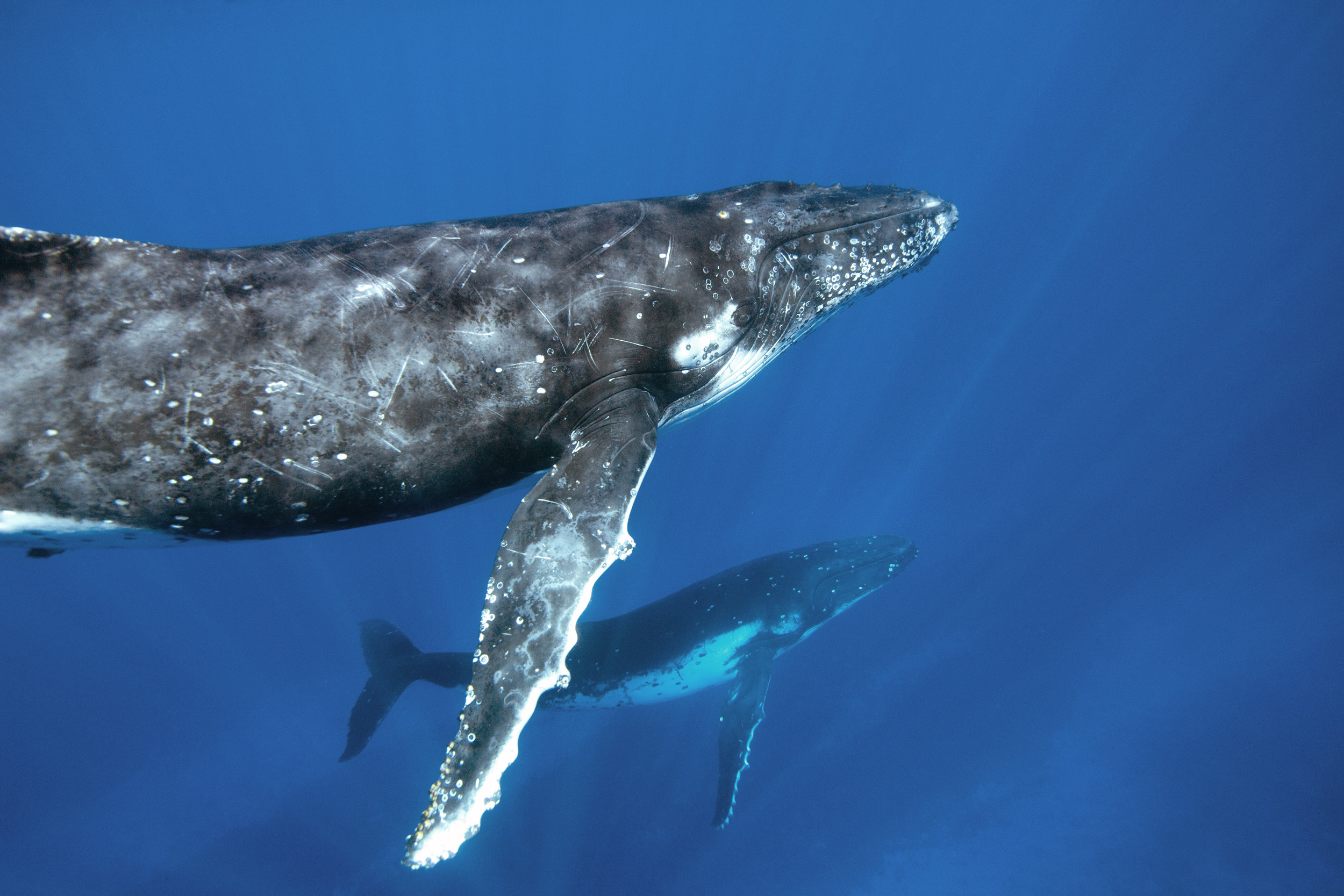
HUMPBACK MIRROR -- A MOTHER AND CALF IN THE SAME POSE. VAVA'U, TONGA, AUGUST 2014
This family duo somehow shared the same position, mirroring each other exactly, for several minutes.
We were with them for over 5 minutes, which doesn’t seem like a long time unless you’re taking 3-15 images a minute,
And an entire series of photographs shows that mother and calf had their pectoral fins in the same position and at the same angle
Nearly the entire time.
This family duo somehow shared the same position, mirroring each other exactly, for several minutes.
We were with them for over 5 minutes, which doesn’t seem like a long time unless you’re taking 3-15 images a minute,
And an entire series of photographs shows that mother and calf had their pectoral fins in the same position and at the same angle
Nearly the entire time.
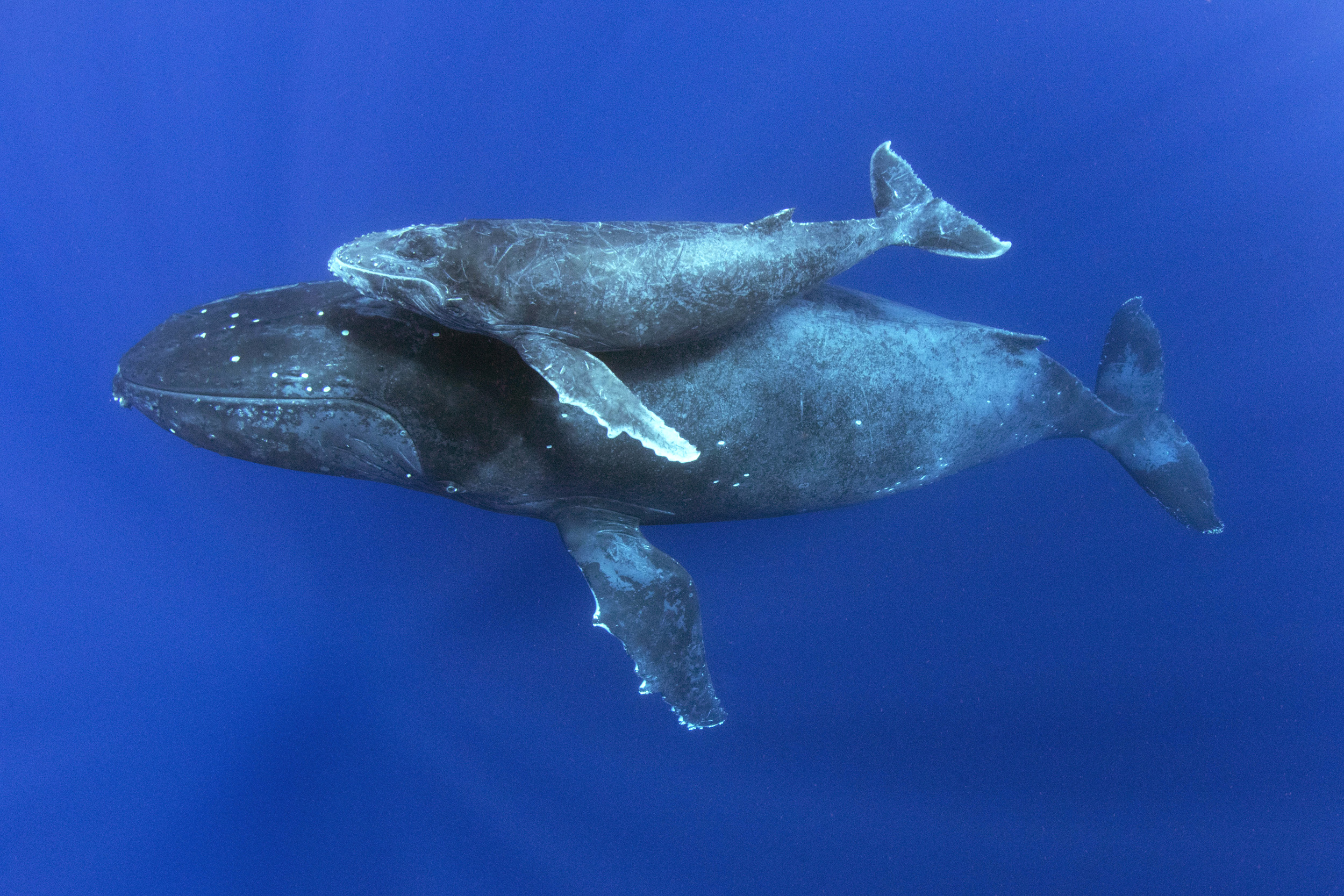
MOTHER AND CALF – HUMPBACKS, VAVA’U, TONGA, AUGUST 2015
Every time I see this August 2015 photograph of a humpback mother and calf, it reminds me of the space shuttle
riding on the back of a Boeing 747. I don’t even see whales anymore...
I have never seen a mum and calf in this exact position since.
This photograph was taken with a fisheye lens, which makes objects appear much farther away than they actually are,
Seems to allow for pictures to stay in focus where other lenses wouldn’t -- when the subject is very close and can distort things slightly (making them look more interesting!) – sometimes completely curving the surface of the water down on either side.
Every time I see this August 2015 photograph of a humpback mother and calf, it reminds me of the space shuttle
riding on the back of a Boeing 747. I don’t even see whales anymore...
I have never seen a mum and calf in this exact position since.
This photograph was taken with a fisheye lens, which makes objects appear much farther away than they actually are,
Seems to allow for pictures to stay in focus where other lenses wouldn’t -- when the subject is very close and can distort things slightly (making them look more interesting!) – sometimes completely curving the surface of the water down on either side.
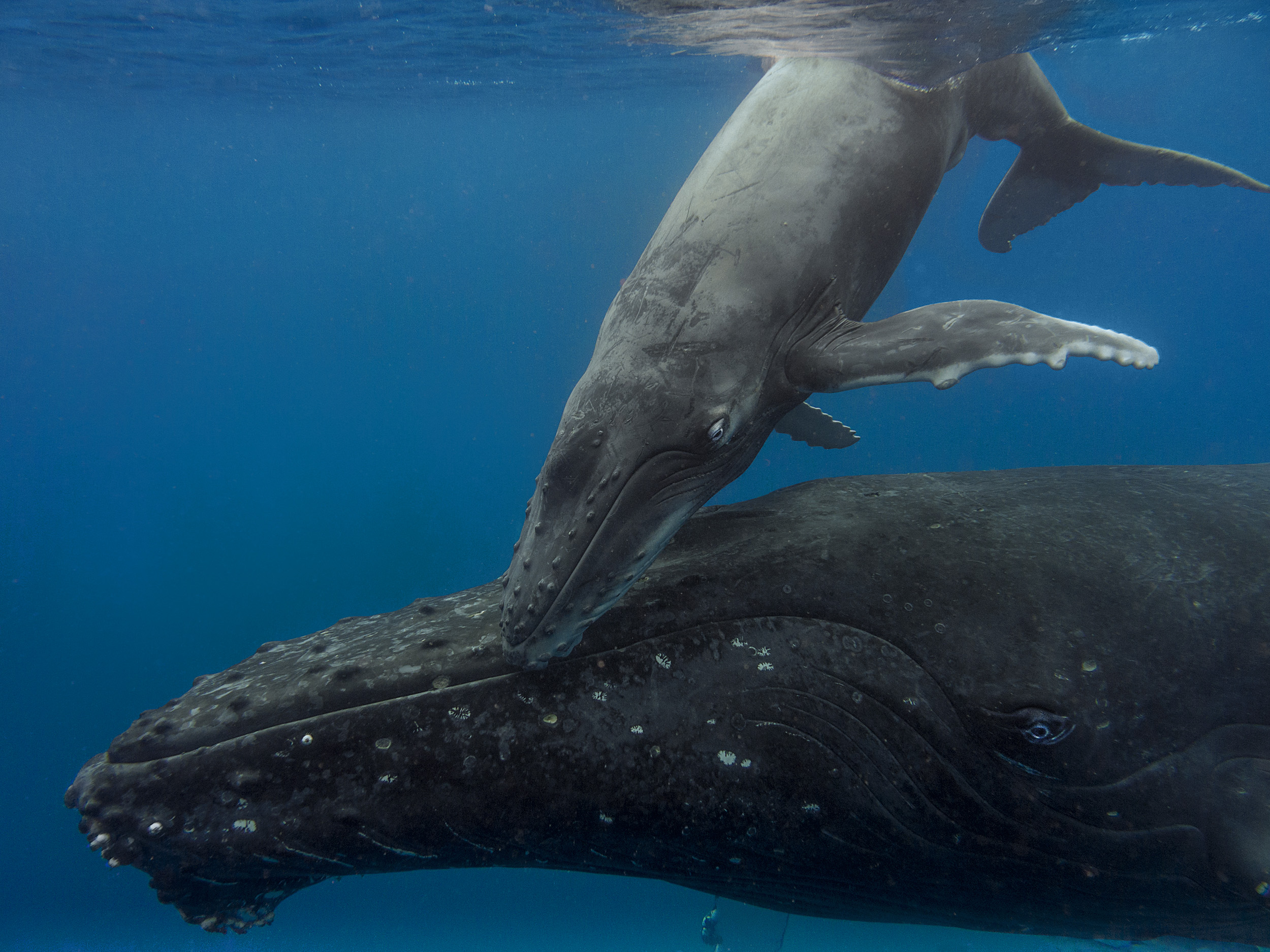
TOUCHING MOMENT – HUMPBACK CALF AND MOTHER
VAVA’U, TONGA, AUGUST 2014
These were the very first whales I ever saw – on my first trip! The calf was very small and mum very watchful.
As I first approached them I was a little intimidated by their size … and the novelty of the experience.
But I quickly fell in love. You would, too! There is absolutely no resisting a mother humpback and her calf.
It’s funny, looking back, that one of the best whale photographs I’ve taken over 5 seasons came from the very first series I took, first
Whales I saw. (And I think results depend on the models, not the photographer, 9 times out of 10 – for all photography)
VAVA’U, TONGA, AUGUST 2014
These were the very first whales I ever saw – on my first trip! The calf was very small and mum very watchful.
As I first approached them I was a little intimidated by their size … and the novelty of the experience.
But I quickly fell in love. You would, too! There is absolutely no resisting a mother humpback and her calf.
It’s funny, looking back, that one of the best whale photographs I’ve taken over 5 seasons came from the very first series I took, first
Whales I saw. (And I think results depend on the models, not the photographer, 9 times out of 10 – for all photography)
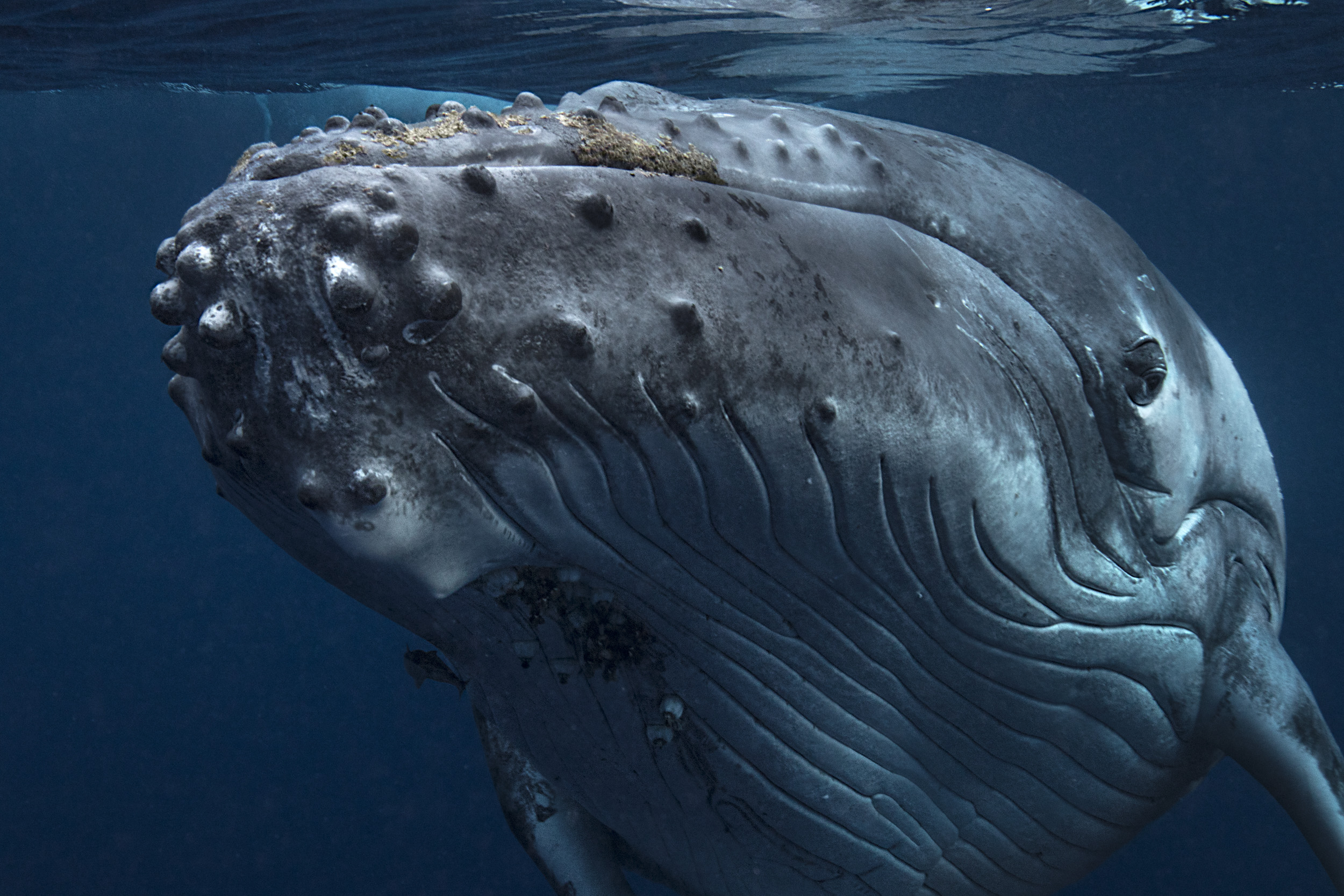
What my friend Tamiko calls “Attack Whale”!
Our first real whale of the 2017 season. The 3 whales in a group on our first day
Were highly preoccupied, possibly with mating on their minds (the beginning of a “heat run”),
And swam off fast each time we got in the water with them.
But THIS whale rushed my guide and friend Alistair and me the very second it saw us.
It turned its head in our direction and just BOLTED at us! Alistair pushed me out
Of the way nervously (I actually wasn’t that scared) but the (large adult) humpback
Dove down a few meters away from us. On our next jump it did the same; but that time
Rushed my friends more than us.
Amazing whale. CRAZY whale!
Our first real whale of the 2017 season. The 3 whales in a group on our first day
Were highly preoccupied, possibly with mating on their minds (the beginning of a “heat run”),
And swam off fast each time we got in the water with them.
But THIS whale rushed my guide and friend Alistair and me the very second it saw us.
It turned its head in our direction and just BOLTED at us! Alistair pushed me out
Of the way nervously (I actually wasn’t that scared) but the (large adult) humpback
Dove down a few meters away from us. On our next jump it did the same; but that time
Rushed my friends more than us.
Amazing whale. CRAZY whale!

MOTHER AND CALF ON THE RISE
HUMPBACK WHALES OFF VAVA’U
TONGA, AUGUST 2015
The water must have been very clear that day, the visibility great.
It has not been good at all the past 2 seasons.
The rays of light shining into very deep water are beautiful. So beautiful in fact
That I occasionally just shoot the rays themselves – or the dark blue spot they
Converge to below you.
The calf in this image is fairly large, so not one of the youngest ones. Younger calves
Are very small (in comparison to adults that can reach 15 meters of length!)
Usually calves are significantly lighter than their mothers for reasons I don’t know,
Which makes this particular calf stand out as different.
HUMPBACK WHALES OFF VAVA’U
TONGA, AUGUST 2015
The water must have been very clear that day, the visibility great.
It has not been good at all the past 2 seasons.
The rays of light shining into very deep water are beautiful. So beautiful in fact
That I occasionally just shoot the rays themselves – or the dark blue spot they
Converge to below you.
The calf in this image is fairly large, so not one of the youngest ones. Younger calves
Are very small (in comparison to adults that can reach 15 meters of length!)
Usually calves are significantly lighter than their mothers for reasons I don’t know,
Which makes this particular calf stand out as different.
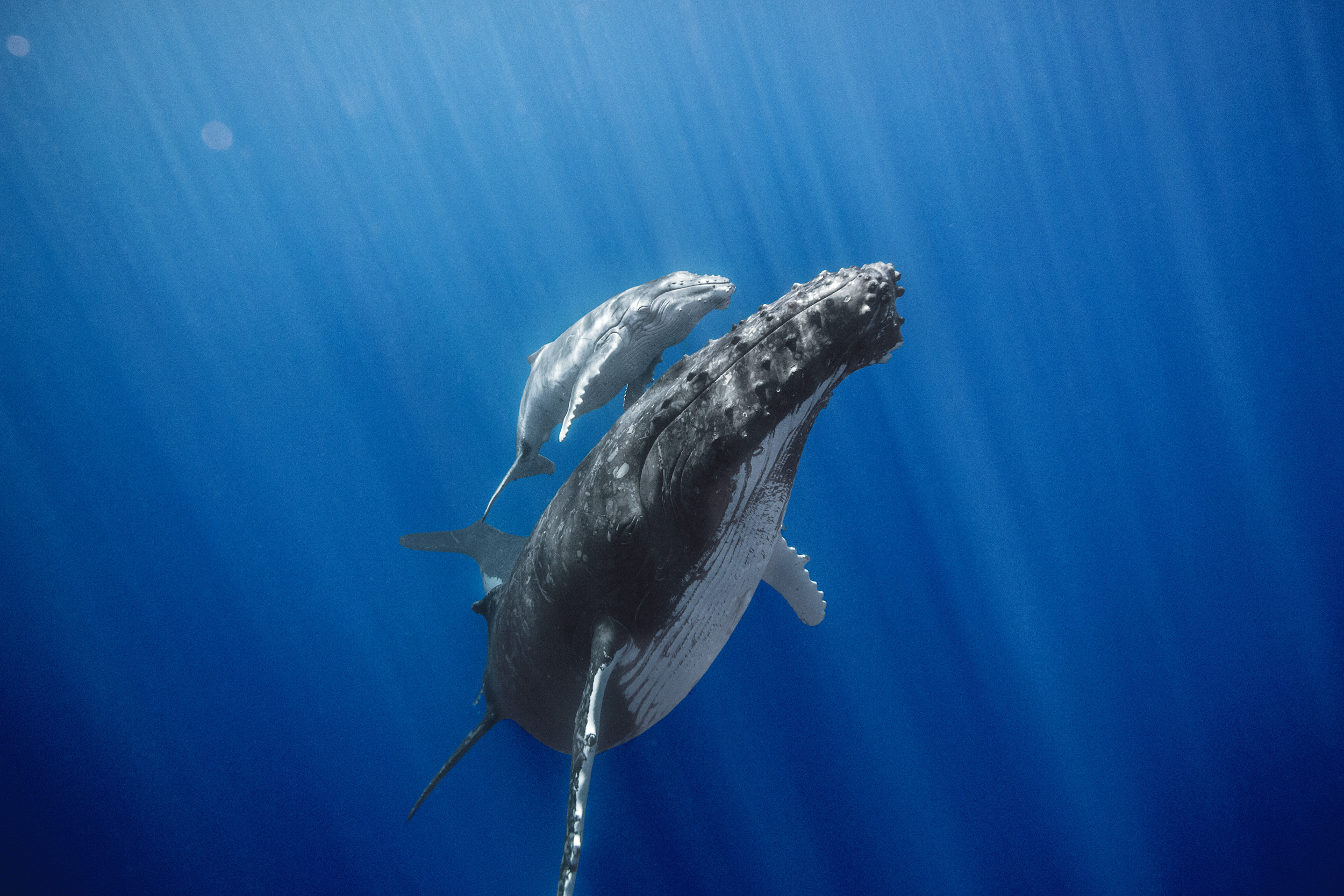
A HUMPBACK WHALE MOTHER AND HER MUCH PALER CALF SLIGHTLY BELOW THE SURFACE - VAVA'U, TONGA, AUGUST 2014
I love the sun rays in this image! But the light circles at the upper left always catch my eye
(Some weird lady I met a few years ago told me that she loves how you can see “spirit auras” in whale photographs,
And that light circles and other strange shapes in the images are auras!)
I love the sun rays in this image! But the light circles at the upper left always catch my eye
(Some weird lady I met a few years ago told me that she loves how you can see “spirit auras” in whale photographs,
And that light circles and other strange shapes in the images are auras!)
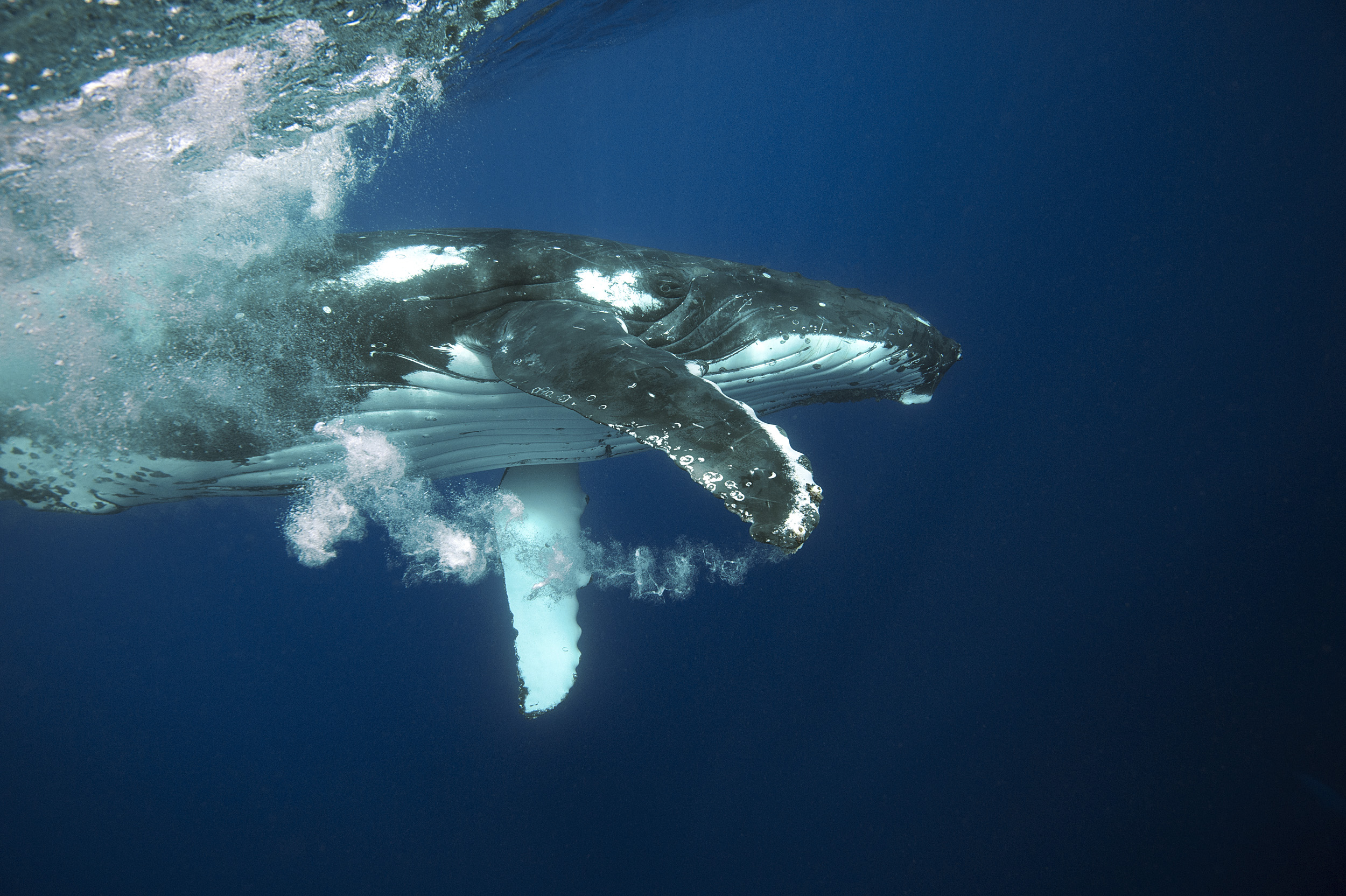
Meet Crazy George!
In Tonga in August last year I had the surprise and privilege of an encounter with a crazy whale! After a fairly bad whale day
(on some days you see next to nothing when scouting for wildlife), we came upon 2 adult whales which at first kept their distance,
But were then active and not shy. Shy or anxious whales swim off – and whale-swimming guides in Vava’u think the calmer and more
Interactive whales have probably been there before and had previous experiences with swimmers.[1]
A few short minutes after we got in with the 2 whales, one of them came EXTREMELY close to me. So close that I could easily have touched it, so close that I think it wanted to touch me. My flippers must have been less than a meter from its nose, and its eye can’t have been more than a meter and a half from mine. It followed me when I tried to swim away – three times! Any effort to lose this whale was an exercise in futility.
At one point, as it seemed to be actively chasing me, I noticed it dip its head under the water, which made me think about the stories I’d heard
Of a whale lifting people on its nose. I swam away as hard as I could when I saw that.
A big surprise to me was that, when I heard stories about Crazy George in the past, I kind of fantasized that maybe one day I would be the person that got lifted out of the water (one swimmer was reportedly actually lifted clear out of the water and placed back in his boat!) in a wild interspecies encounter…
But when facing that eventuality I was – a bit embarrassingly – overcome with fear. What if I fall on the whale’s head? If I knee or elbow it really hard? What if it throws me a bit? What if I scratch one of his eyes with my (large, heavy) camera? What if we somehow decide that we don’t like each other? If close proximity and two very different sets of intentions push us apart. Regardless of your knowledge that this animal is a plankton feeder, only eating little fish on rare occasions, when it’s actually upon you and you can see its 9- to 15-meter body you get scared.
I was actually using someone else’s camera that week. Just as had happened to a friend the year before, my luggage didn’t arrive in Vava’u for my first 6 days… and, just like with my friend the year before, my bags had been sitting at the airport for a day or 2 before I retrieved them! No one called to inform us. My guide for the 4th year in a row, Alistair, asked his assistant to lend me his camera, which he did.
After the incredible encounter with George, I think the guy was jealous (and hoping George would repeat his behaviour with him)… because he immediately asked me if he could take his camera back for the next swim!
This particular image of George was taken a few seconds after he stopped harassing me and shows him just before he rolled and showed us his underside.
The bubbles from moving his pectoral fin quite fast are fun.
By this stage George’s companion had gone quite far away from us, and I only saw George for a few more seconds.
[1] And the mothers come back to give birth where they themselves were born.
In Tonga in August last year I had the surprise and privilege of an encounter with a crazy whale! After a fairly bad whale day
(on some days you see next to nothing when scouting for wildlife), we came upon 2 adult whales which at first kept their distance,
But were then active and not shy. Shy or anxious whales swim off – and whale-swimming guides in Vava’u think the calmer and more
Interactive whales have probably been there before and had previous experiences with swimmers.[1]
A few short minutes after we got in with the 2 whales, one of them came EXTREMELY close to me. So close that I could easily have touched it, so close that I think it wanted to touch me. My flippers must have been less than a meter from its nose, and its eye can’t have been more than a meter and a half from mine. It followed me when I tried to swim away – three times! Any effort to lose this whale was an exercise in futility.
At one point, as it seemed to be actively chasing me, I noticed it dip its head under the water, which made me think about the stories I’d heard
Of a whale lifting people on its nose. I swam away as hard as I could when I saw that.
A big surprise to me was that, when I heard stories about Crazy George in the past, I kind of fantasized that maybe one day I would be the person that got lifted out of the water (one swimmer was reportedly actually lifted clear out of the water and placed back in his boat!) in a wild interspecies encounter…
But when facing that eventuality I was – a bit embarrassingly – overcome with fear. What if I fall on the whale’s head? If I knee or elbow it really hard? What if it throws me a bit? What if I scratch one of his eyes with my (large, heavy) camera? What if we somehow decide that we don’t like each other? If close proximity and two very different sets of intentions push us apart. Regardless of your knowledge that this animal is a plankton feeder, only eating little fish on rare occasions, when it’s actually upon you and you can see its 9- to 15-meter body you get scared.
I was actually using someone else’s camera that week. Just as had happened to a friend the year before, my luggage didn’t arrive in Vava’u for my first 6 days… and, just like with my friend the year before, my bags had been sitting at the airport for a day or 2 before I retrieved them! No one called to inform us. My guide for the 4th year in a row, Alistair, asked his assistant to lend me his camera, which he did.
After the incredible encounter with George, I think the guy was jealous (and hoping George would repeat his behaviour with him)… because he immediately asked me if he could take his camera back for the next swim!
This particular image of George was taken a few seconds after he stopped harassing me and shows him just before he rolled and showed us his underside.
The bubbles from moving his pectoral fin quite fast are fun.
By this stage George’s companion had gone quite far away from us, and I only saw George for a few more seconds.
[1] And the mothers come back to give birth where they themselves were born.
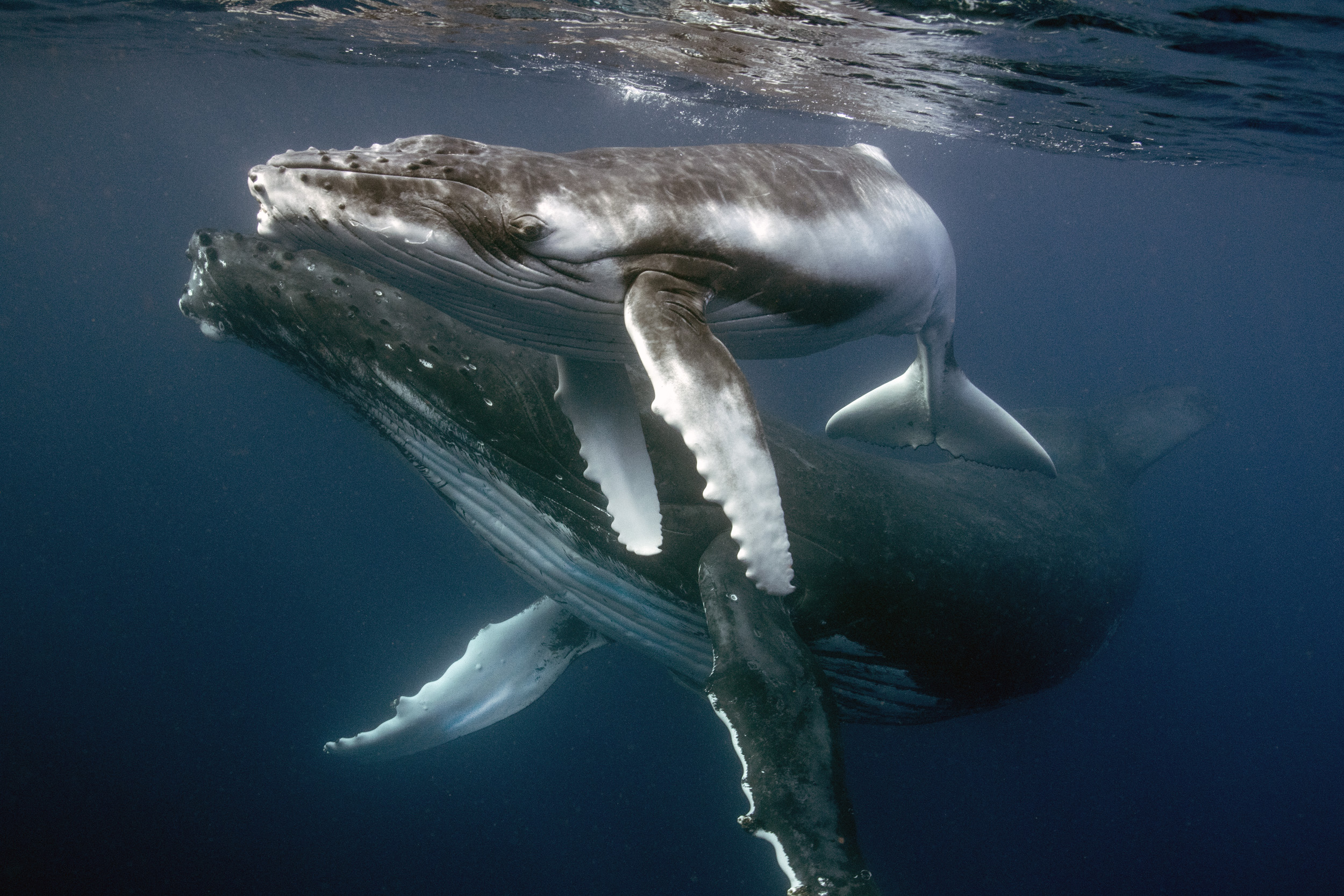
POSSIBLY THE MOST TOUCHING “MUM AND CALF” FROM MY AUGUST 2018 TRIP!
The colour contrast of this calf, on its own body but also juxtaposed with its mother, was quite marked.
I wish the rest of the mother’s pectoral fin were in here. But then the calf wouldn’t appear as close.
The colour contrast of this calf, on its own body but also juxtaposed with its mother, was quite marked.
I wish the rest of the mother’s pectoral fin were in here. But then the calf wouldn’t appear as close.
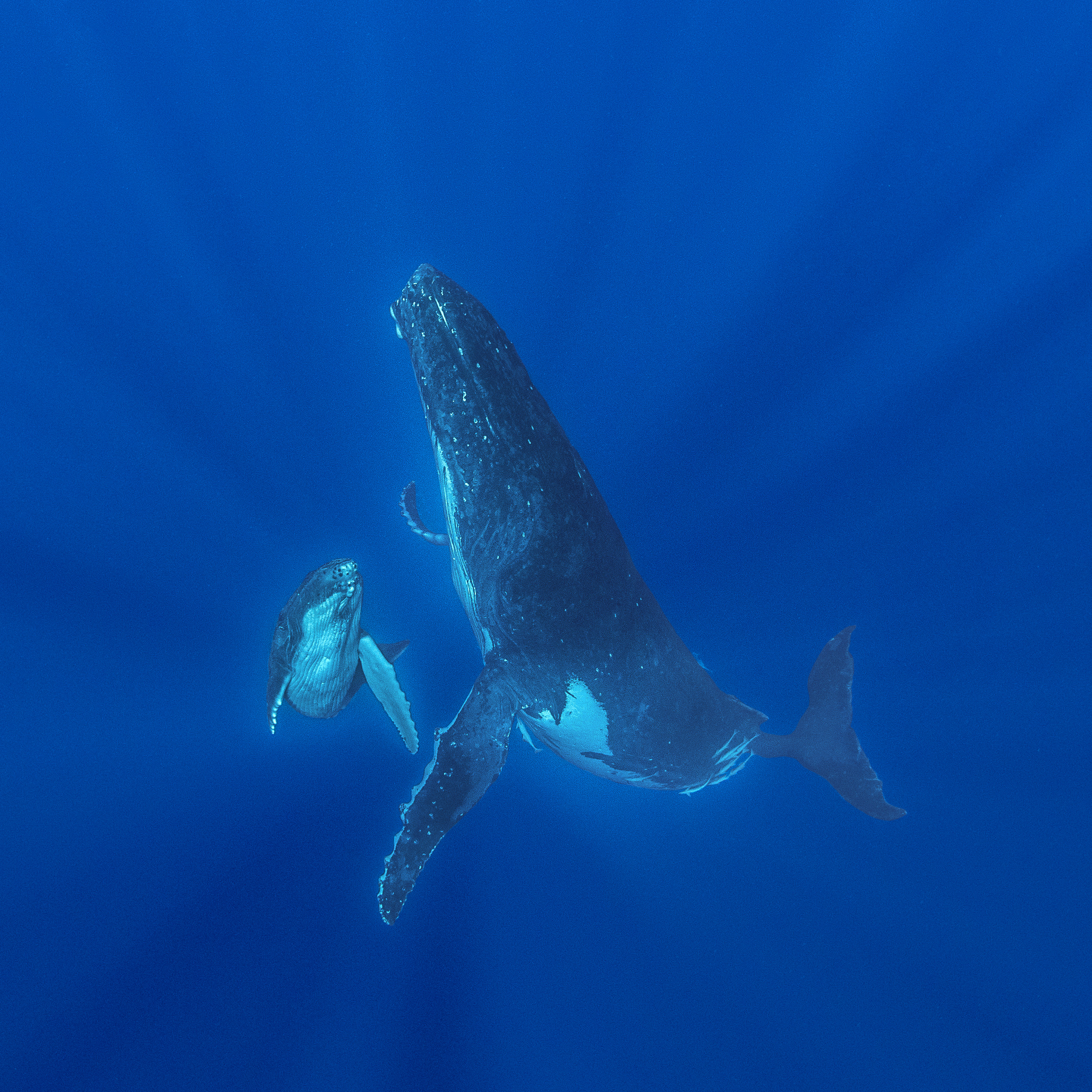
ONE OF MY VERY FAVOURITE HUMPBACK IMAGES… AUGUST 2015
This humpback duo was in ultra-clear water quite a distance away from port.
We never know where we’ll find the whales (if any whales) on any given day. Sometimes we see them a kilometre from home -- Neiafu, right after we leave (at 7 or 7:30 a.m.). Sometimes we are an hour or more away.
Visibility is sometimes very mediocre or even really bad. Particles are extremely obvious in sunlight.
Entire seasons can be bad for photography. In 2019 we had strands of green matter everywhere in the water,
And for any image to look good the water will need to be significantly digitally cleaned up; colour contrasts probably enhanced.
It’s surprising how much organic matter can be in Vava’u waters … and it seems almost unbelievable that the whales don’t actively feed there.
The calves suckle; but adults eat elsewhere.
In this image I love how detached the calf seems from its mother, almost as if it carried its own light with it.
This humpback duo was in ultra-clear water quite a distance away from port.
We never know where we’ll find the whales (if any whales) on any given day. Sometimes we see them a kilometre from home -- Neiafu, right after we leave (at 7 or 7:30 a.m.). Sometimes we are an hour or more away.
Visibility is sometimes very mediocre or even really bad. Particles are extremely obvious in sunlight.
Entire seasons can be bad for photography. In 2019 we had strands of green matter everywhere in the water,
And for any image to look good the water will need to be significantly digitally cleaned up; colour contrasts probably enhanced.
It’s surprising how much organic matter can be in Vava’u waters … and it seems almost unbelievable that the whales don’t actively feed there.
The calves suckle; but adults eat elsewhere.
In this image I love how detached the calf seems from its mother, almost as if it carried its own light with it.
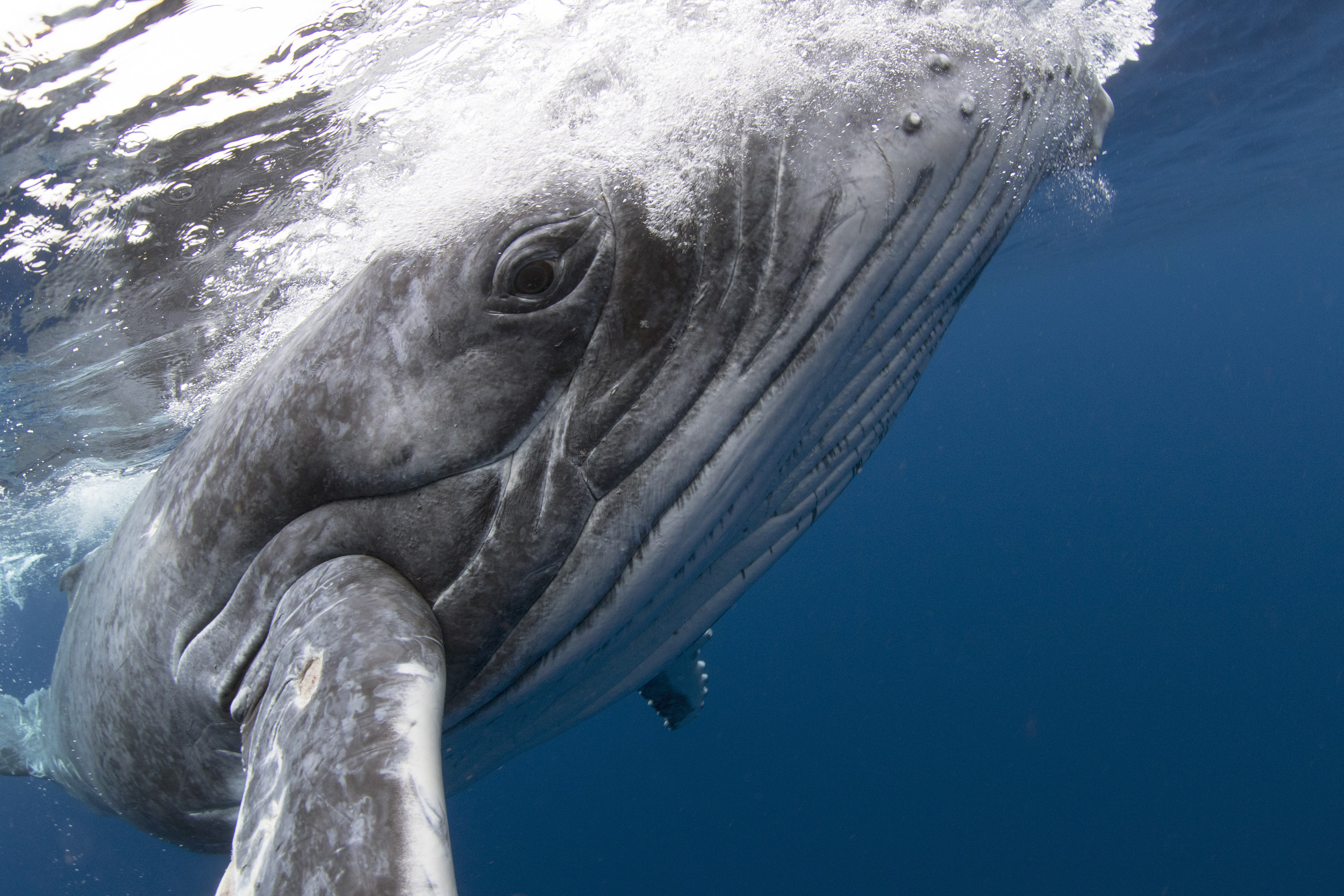
BUMPING INTO A DELIGHTFULLY CURIOUS HUMPBACK WHALE CALF.
VAVA’U, TONGA, AUGUST 2015
One of the most incredible moments of all time (for me!) – and a first in my life at that point
This calf first bumped my friend Trevor, apparently hurting his shin…
And then it bumped me.
Its pass seemed like it took a while, almost frozen in time, and there is a whole
Set of images, including from meters away moments before and until its tail was in the distance.
This photograph is just the best in a much wider set. The best capture of a moment I shall – can – never forget.
VAVA’U, TONGA, AUGUST 2015
One of the most incredible moments of all time (for me!) – and a first in my life at that point
This calf first bumped my friend Trevor, apparently hurting his shin…
And then it bumped me.
Its pass seemed like it took a while, almost frozen in time, and there is a whole
Set of images, including from meters away moments before and until its tail was in the distance.
This photograph is just the best in a much wider set. The best capture of a moment I shall – can – never forget.
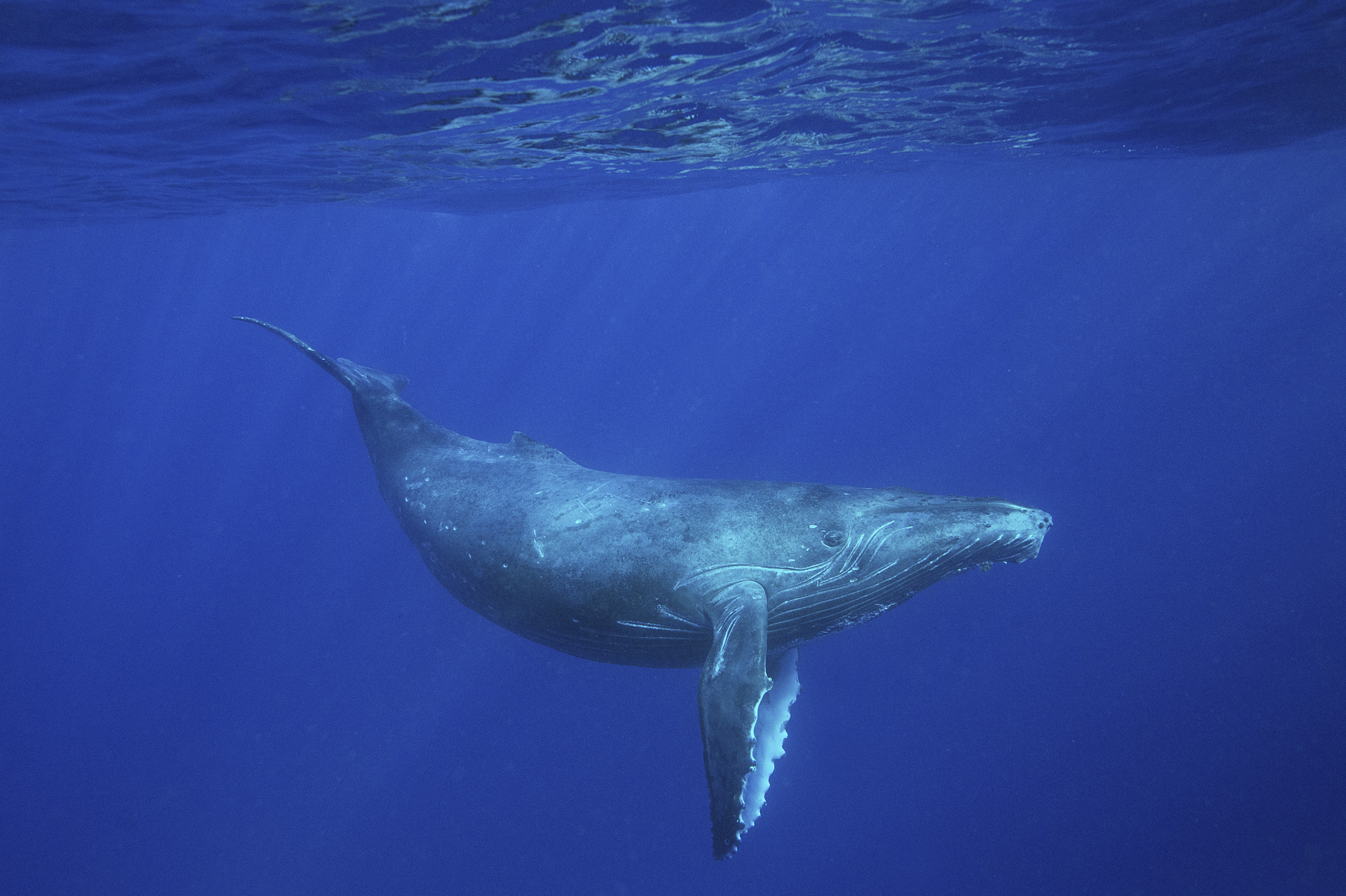
This time the pectorals are in the picture!
A CALF JUST UNDER THE SURFACE IN A TYPICAL POSE.
VAVA’U, AUGUST 2018
A CALF JUST UNDER THE SURFACE IN A TYPICAL POSE.
VAVA’U, AUGUST 2018
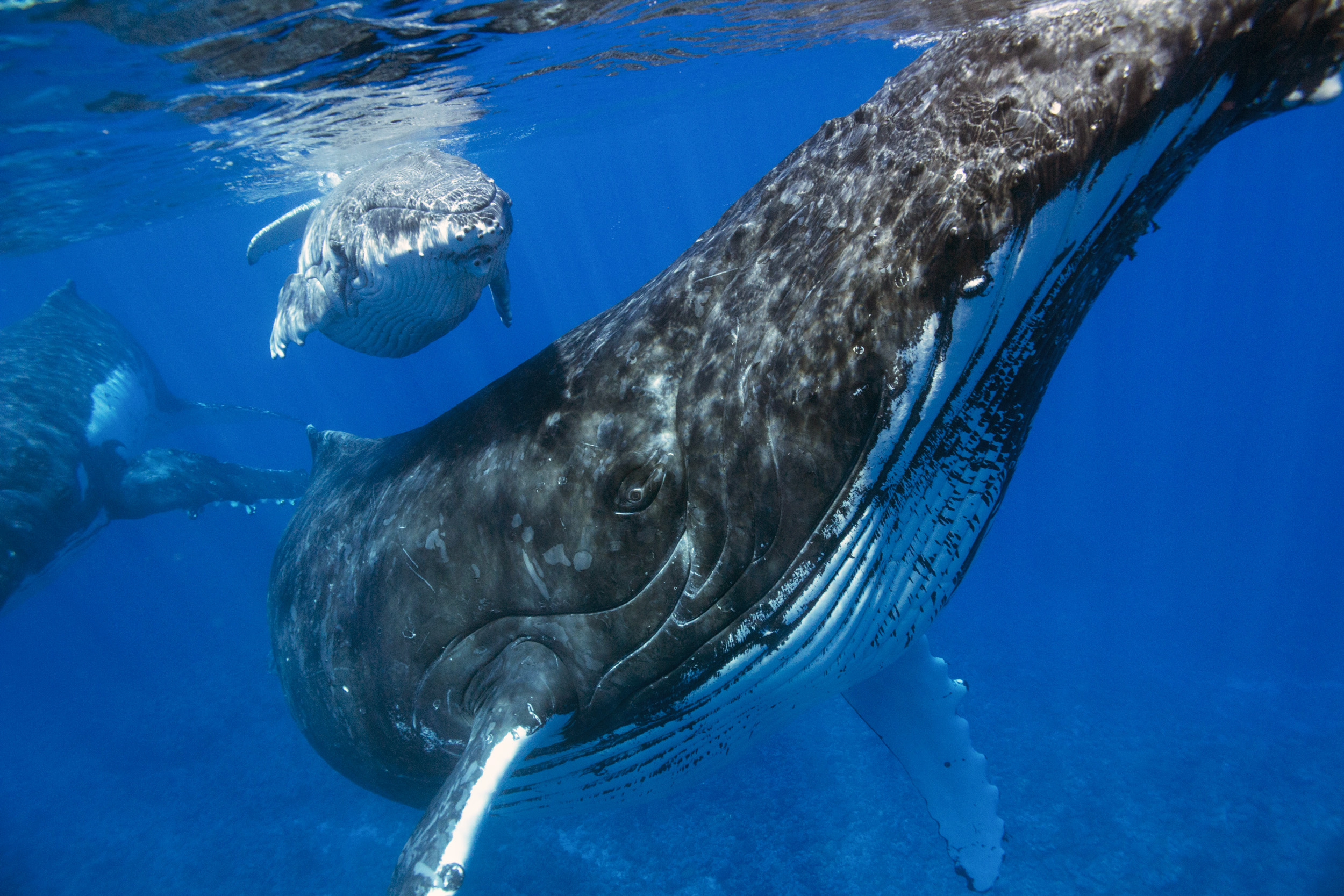
A humpback whale calf swims above its much larger mother, with the male escort trailing behind.
VAVA’U, TONGA, AUGUST 2014
VAVA’U, TONGA, AUGUST 2014
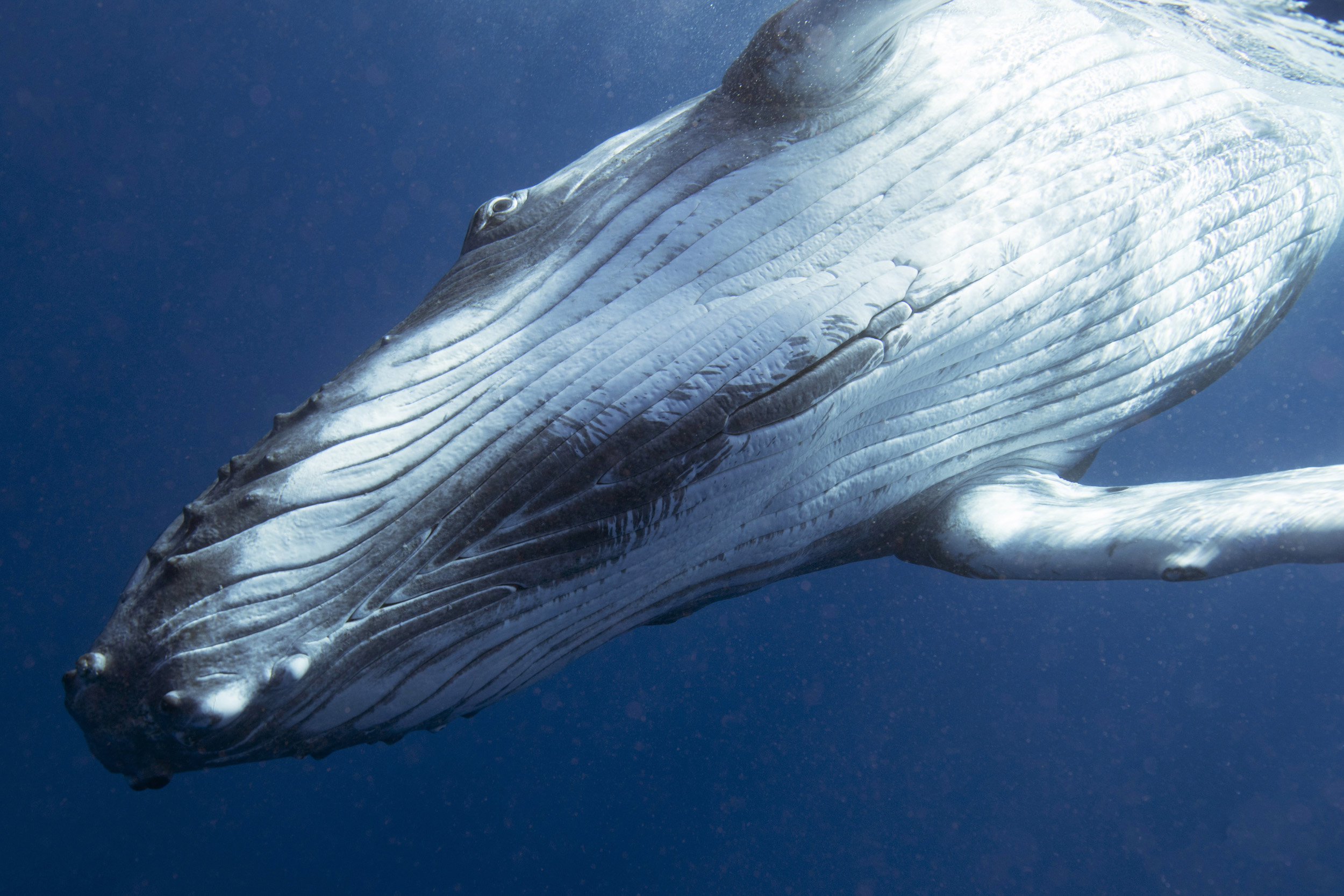
Sometimes they go diagonal…
THIS CALF, FROM OUR AUGUST 2017 TRIP, WAS EXTREMELY CURIOUS AND INTERACTIVE.
Humpbacks keep their eye on you even as they roll. Sometimes you notice them staring at you
At the most unlikely time… and when you think they’ve got over you, having long accepted you as a strange
Dolphin or fish.
Protective mothers in particular pay close attention to you, their eyes staring straight at you
Even when the eye is the body part the furthest away from you.
I love the dark patch centered on this guy (or girl)’s throat…
THIS CALF, FROM OUR AUGUST 2017 TRIP, WAS EXTREMELY CURIOUS AND INTERACTIVE.
Humpbacks keep their eye on you even as they roll. Sometimes you notice them staring at you
At the most unlikely time… and when you think they’ve got over you, having long accepted you as a strange
Dolphin or fish.
Protective mothers in particular pay close attention to you, their eyes staring straight at you
Even when the eye is the body part the furthest away from you.
I love the dark patch centered on this guy (or girl)’s throat…
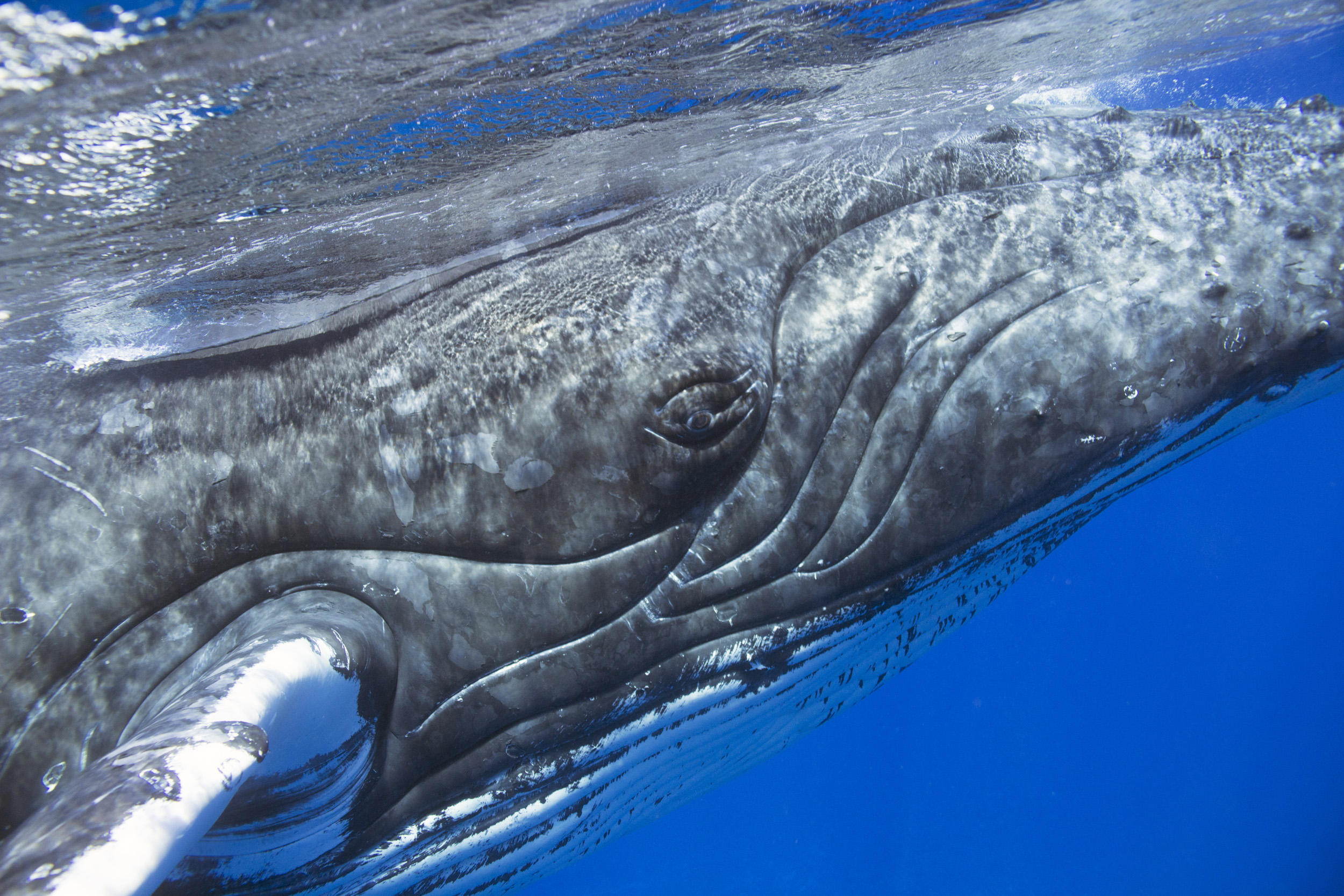
What a face!
ADULT HUMPBACK WHALE, TONGA. SUMMER 2014.
ADULT HUMPBACK WHALE, TONGA. SUMMER 2014.
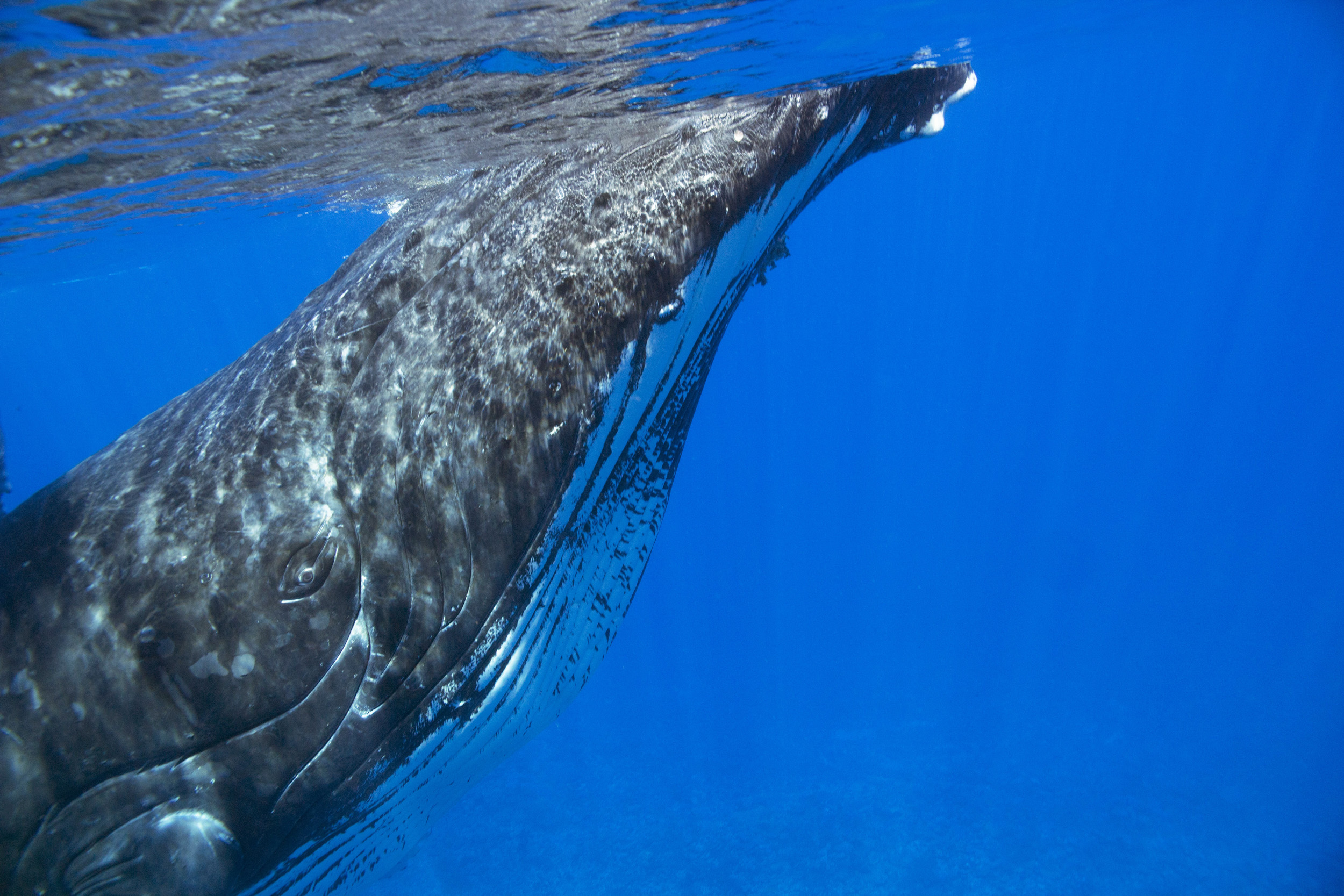
A MOTHER’S SURPRISED-LOOKING EYE! HUMPBACK IN AUGUST 2014. VAVA’U, TONGA
Some cetaceans’ eyes seem more expressive, their look more surprised, than others.
This was one such case during my first season in Tonga.
Whales arrive in Vava’u in May or June and depart by late October.
Some cetaceans’ eyes seem more expressive, their look more surprised, than others.
This was one such case during my first season in Tonga.
Whales arrive in Vava’u in May or June and depart by late October.
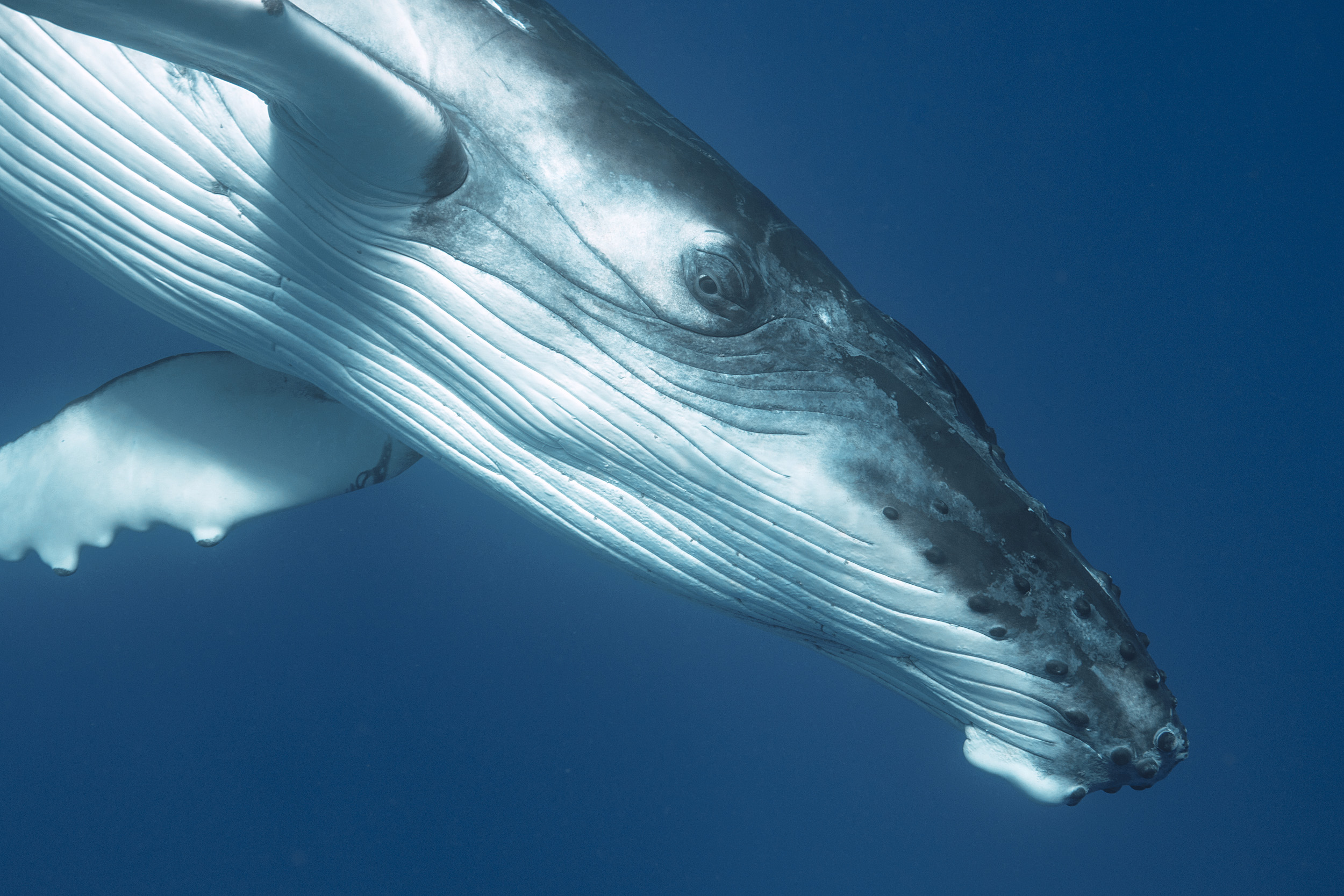
JUST ANOTHER LOVELY CALF DOING ITS ROUNDS, WATCHING US FROM CLOSE… AUGUST 2018 IN TONGA
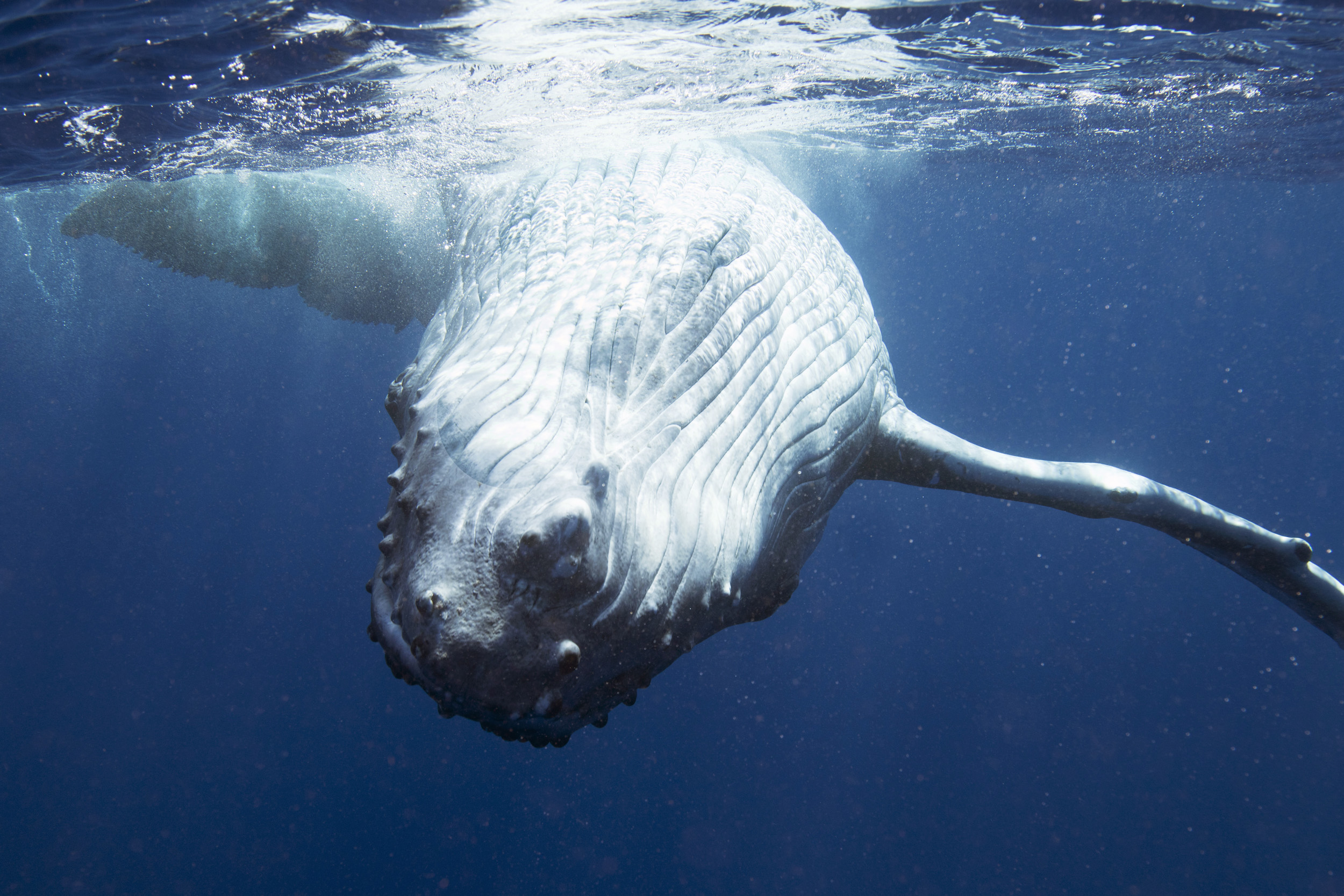
HUMPBACK CALF, PRE-BUMP! VAVA’U IN AUGUST 2017
This calf was a wild explorer and multi-bumper.
When they flip over and approach you upside down, you know something special is about to happen…
This specific whale did real tours of our group – as if organized by a travel agent ! – and seemed a professional person-pusher.
This calf was a wild explorer and multi-bumper.
When they flip over and approach you upside down, you know something special is about to happen…
This specific whale did real tours of our group – as if organized by a travel agent ! – and seemed a professional person-pusher.
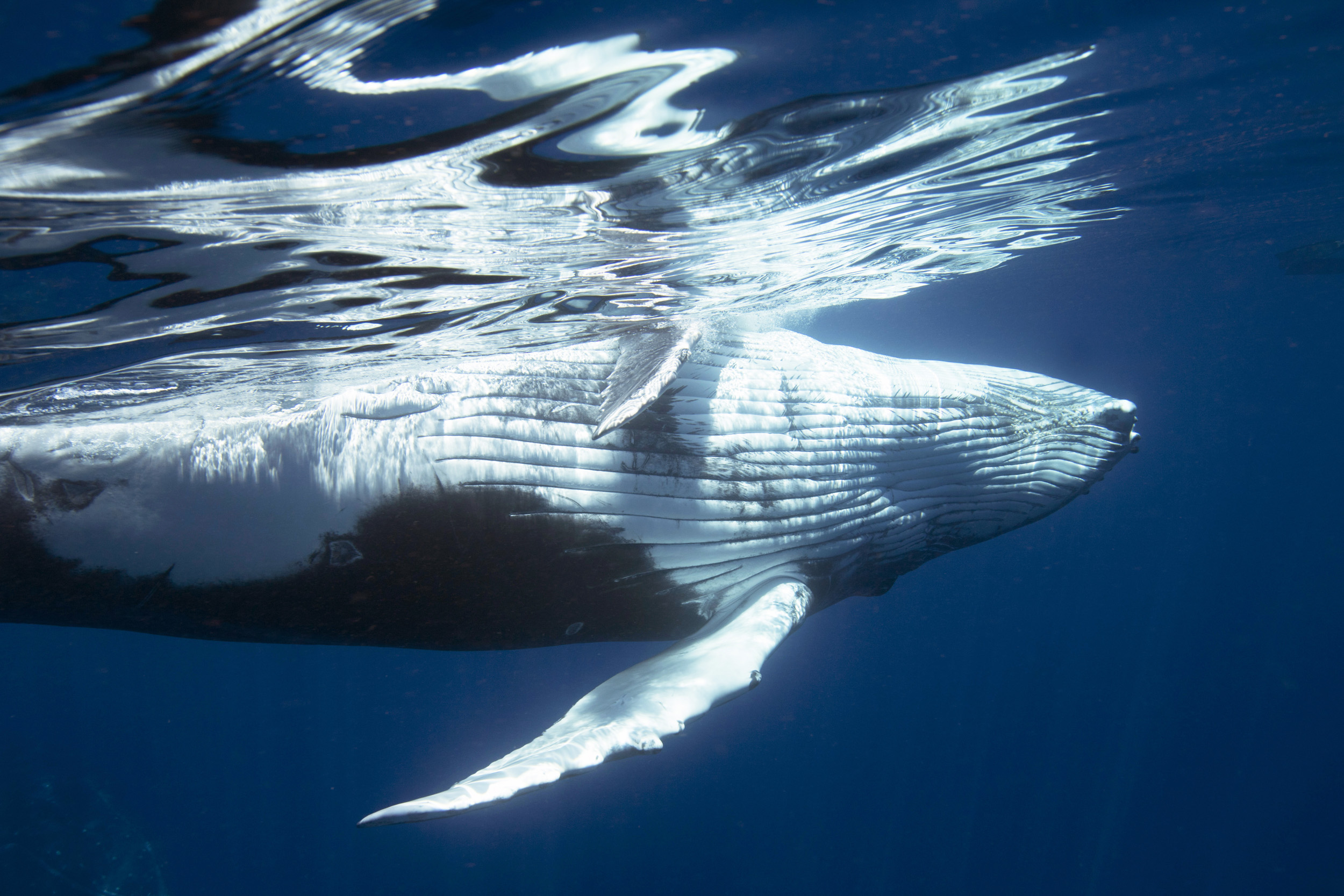
A MOTHER HUMPBACK WHALE TURNS TOWARDS ME, HER FINS OUTSTRETCHED AND EYE WIDE OPEN
VAVA’U, TONGA, IN AUGUST 2017
TRULY one of the most amazing, gratifying moments an animal has ever graced me with.
This mother turned to me, spreading her immense pectoral fins as she hovered vertical, her calf having just moved off behind her.
You can really feel a connection with an intelligent animal when it looks straight at you. This is particularly true of whales and dolphins.
This humpback’s eye was looking right at me, nearly through me.
I only had her facing me for a few seconds, seconds I will never forget.
Initially she was turned away, watching her calf move… but she nearly brushed me with her pectoral fin as
She rotated. In so doing she came much closer to me, ending up maybe 5-6 meters away instead of 8-10.
Because of my fisheye lens, she looks further away than she was.
This privilege will stay with me for decades – or perhaps a lifetime. I never know whether to hang prints of this image horizontal or vertical… Both work.
VAVA’U, TONGA, IN AUGUST 2017
TRULY one of the most amazing, gratifying moments an animal has ever graced me with.
This mother turned to me, spreading her immense pectoral fins as she hovered vertical, her calf having just moved off behind her.
You can really feel a connection with an intelligent animal when it looks straight at you. This is particularly true of whales and dolphins.
This humpback’s eye was looking right at me, nearly through me.
I only had her facing me for a few seconds, seconds I will never forget.
Initially she was turned away, watching her calf move… but she nearly brushed me with her pectoral fin as
She rotated. In so doing she came much closer to me, ending up maybe 5-6 meters away instead of 8-10.
Because of my fisheye lens, she looks further away than she was.
This privilege will stay with me for decades – or perhaps a lifetime. I never know whether to hang prints of this image horizontal or vertical… Both work.
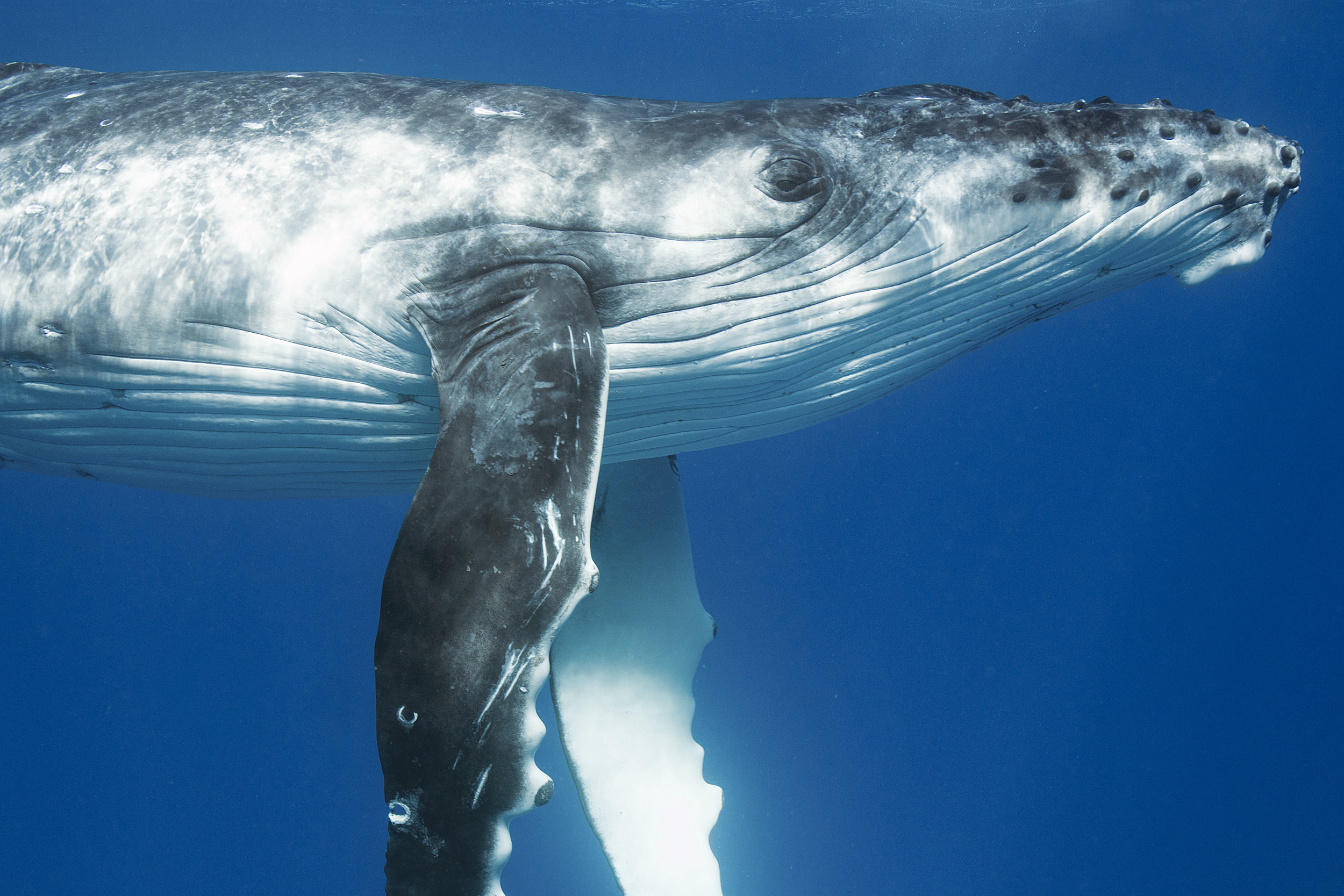
A CURIOUS CALF ON A SURFACE VISIT! VAVA’U IN AUGUST 2018
Sometimes they come remarkably close and seem to be as interested in us as we are in them.
This calf spent a lot of its time wandering around us each time it surfaced for air.
It’s a bit of a shame I cut the bottom of its pectoral fins off in this image.
Sometimes when you try to prioritize a face, as I do, you don’t fit everything in.
Sometimes they come remarkably close and seem to be as interested in us as we are in them.
This calf spent a lot of its time wandering around us each time it surfaced for air.
It’s a bit of a shame I cut the bottom of its pectoral fins off in this image.
Sometimes when you try to prioritize a face, as I do, you don’t fit everything in.
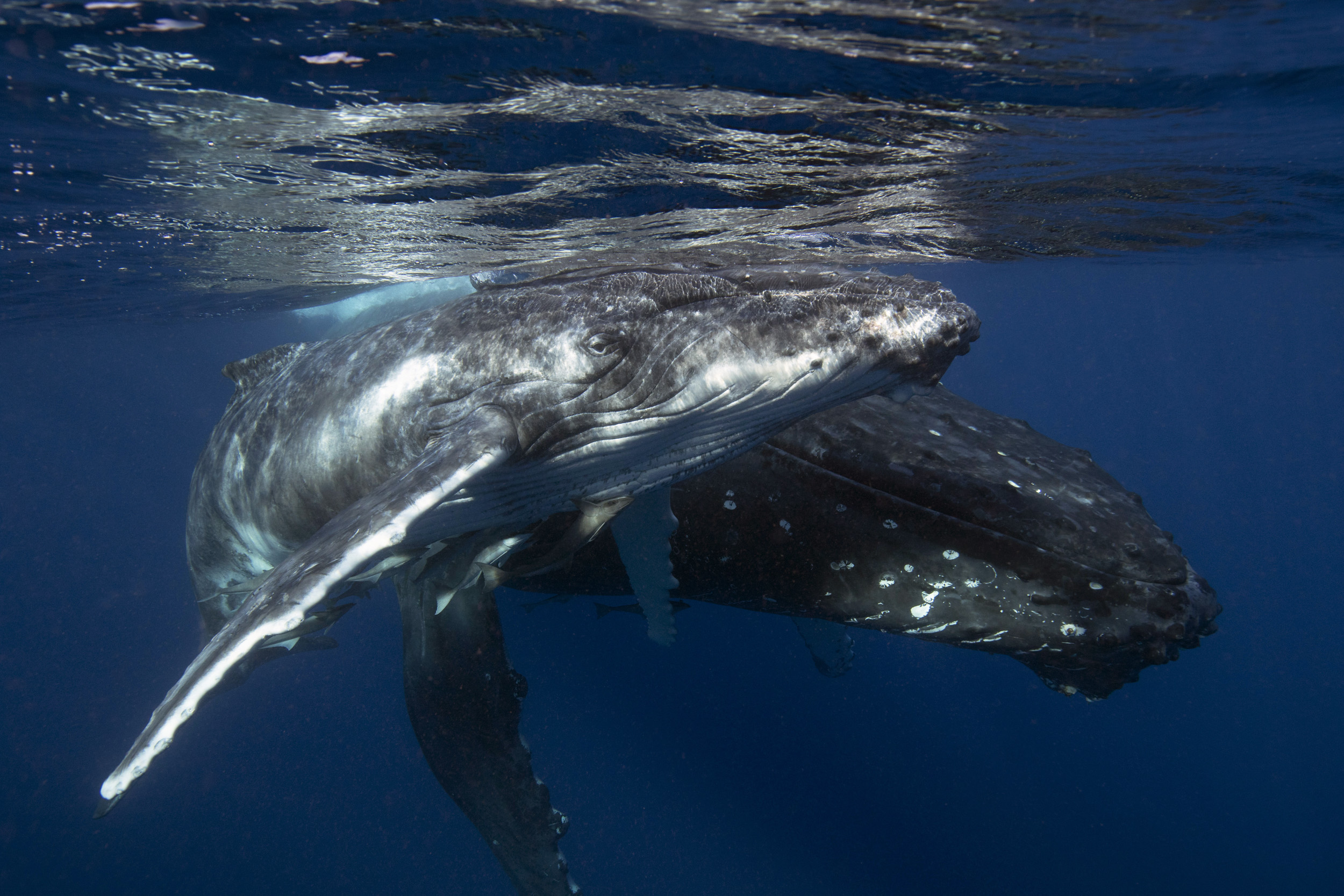
HUMPBACK MOTHER AND CALF VERY CLOSE. VAVA’U, TONGA, AUGUST 2017
I’m not sure there’s anything in the world that compares to a baby whale and its mother – or the delight you feel being close
To them.
We usually stay a good number of meters away from them; but sometimes they come towards us – or someone, whale or human, drifts in the current.
My friend/guide Alistair and I always joke that we haven’t broken the proximity rules: “they came to me! I promise…”
(One always intends not to, but sometimes you unconsciously approach)
I’m not sure there’s anything in the world that compares to a baby whale and its mother – or the delight you feel being close
To them.
We usually stay a good number of meters away from them; but sometimes they come towards us – or someone, whale or human, drifts in the current.
My friend/guide Alistair and I always joke that we haven’t broken the proximity rules: “they came to me! I promise…”
(One always intends not to, but sometimes you unconsciously approach)
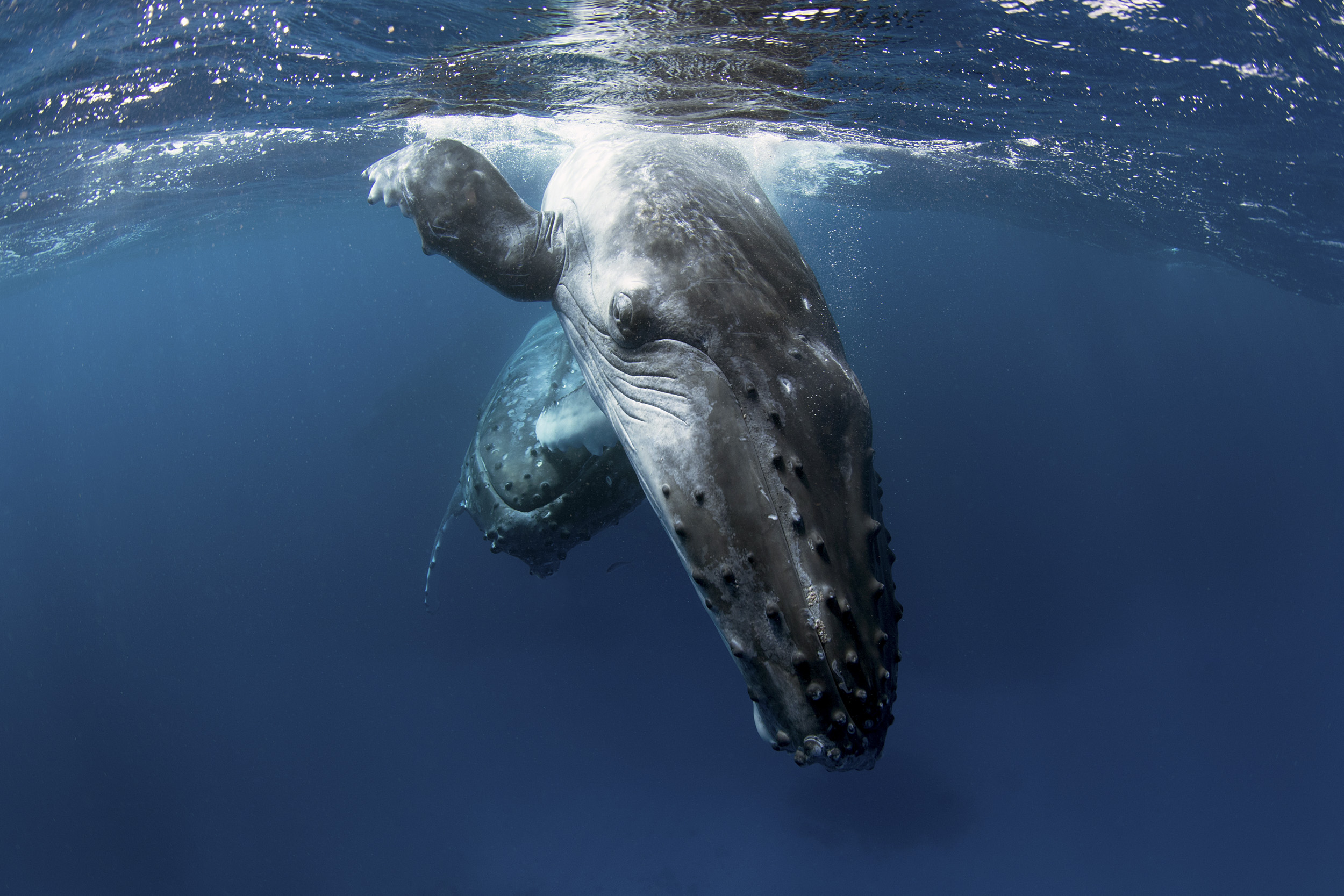
OUR LAST TRIO OF MOTHER, CALF AND ESCORT OF THE 2018 SEASON.
The escort isn’t visible in this photograph.
The sea was fairly rough that day, but we had multiple good swims with them.
It’s always nice when you get a good send-off – friendly animals – one of the very last days
Of a trip, and you leave on a high.
The calf was about to bump me – you can see it diving here seconds before.
Moments later its tail hit my chest as it descended.
My snorkel had just flooded when the whales were approaching, so it’s
Nice that some of the images turned out well despite my being unable to breathe, gurgling.
The escort isn’t visible in this photograph.
The sea was fairly rough that day, but we had multiple good swims with them.
It’s always nice when you get a good send-off – friendly animals – one of the very last days
Of a trip, and you leave on a high.
The calf was about to bump me – you can see it diving here seconds before.
Moments later its tail hit my chest as it descended.
My snorkel had just flooded when the whales were approaching, so it’s
Nice that some of the images turned out well despite my being unable to breathe, gurgling.
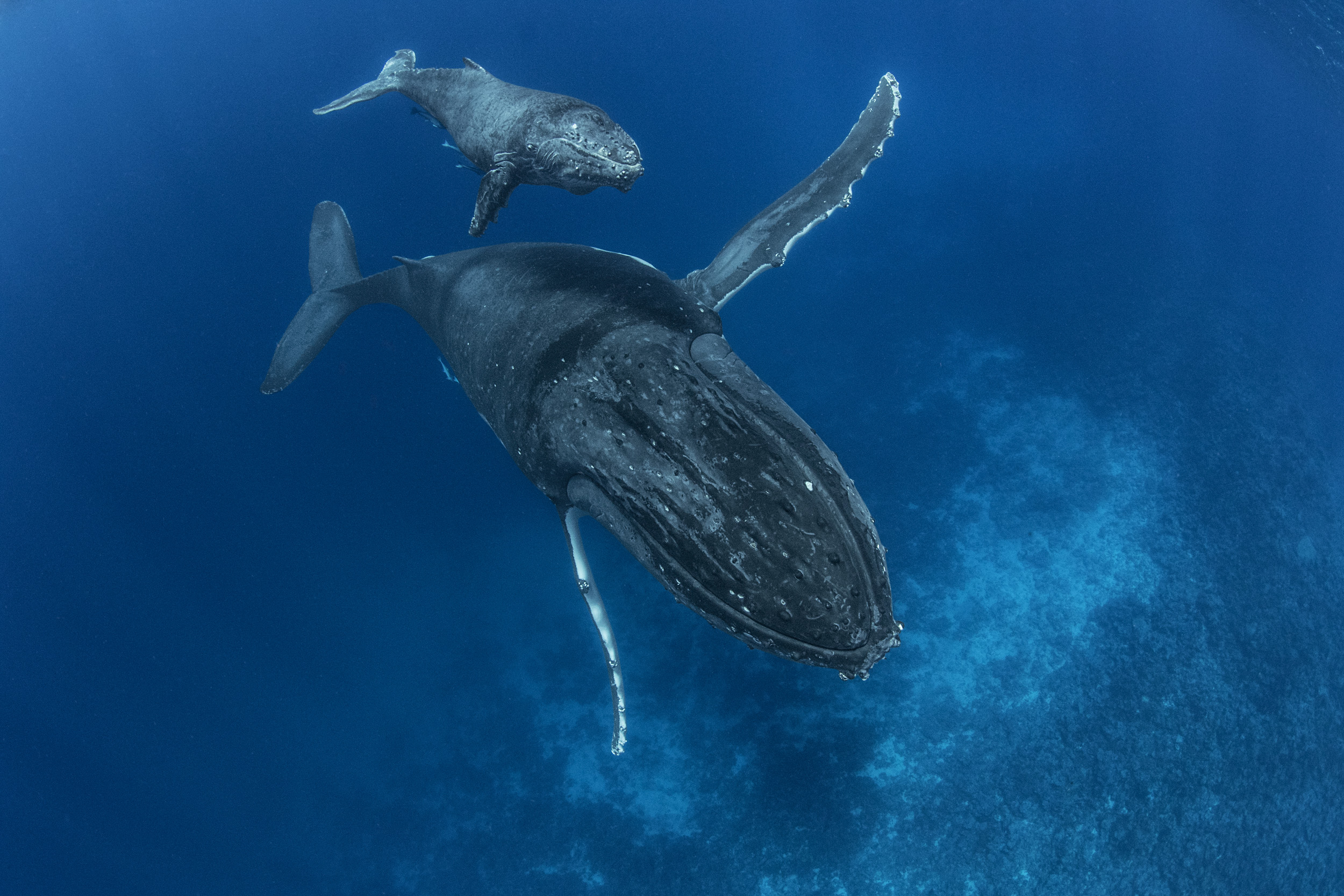
BEAUTIFULLY COORDINATED MOTHER AND CALF SWOOPING IN.
VAVA’U, TONGA, AUGUST 2015
We were only with these guys for a short time.
We rarely see the whales in such shallow water, making this image
A little exceptional.
They passed right below me, the calf perhaps 2 meters under, moments later.
I was surprised that they didn’t choose an alternate route!
Some of the images of them directly underneath me are a bit more interesting,
Less typical, than this one. The calf’s tail, which seemed enormous, was mottled,
And looked a strange tinge of grey-yellow.
VAVA’U, TONGA, AUGUST 2015
We were only with these guys for a short time.
We rarely see the whales in such shallow water, making this image
A little exceptional.
They passed right below me, the calf perhaps 2 meters under, moments later.
I was surprised that they didn’t choose an alternate route!
Some of the images of them directly underneath me are a bit more interesting,
Less typical, than this one. The calf’s tail, which seemed enormous, was mottled,
And looked a strange tinge of grey-yellow.
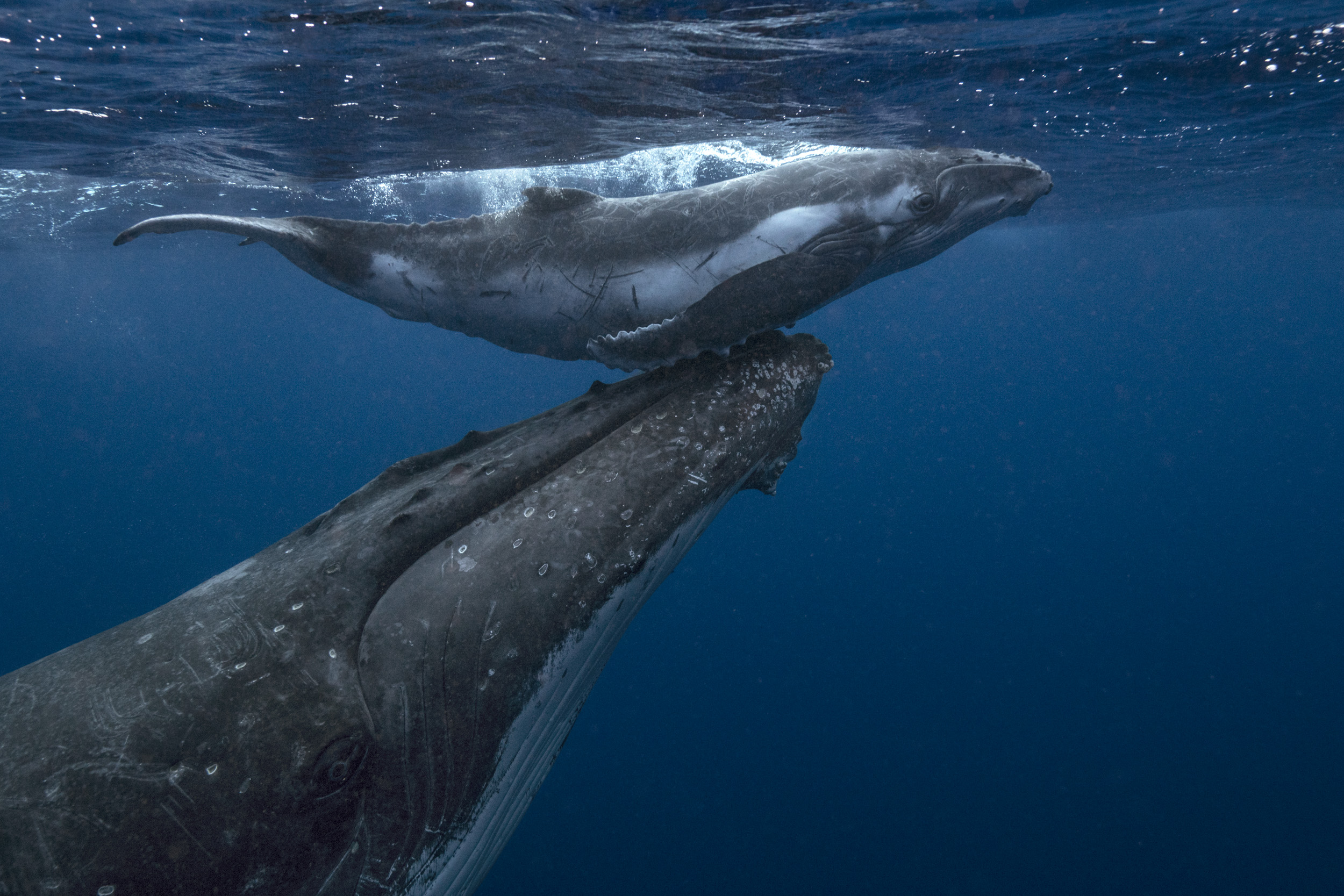
A HUMPBACK WHALE SUPPORTS HER CALF AT THE SURFACE,
VAVA’U, TONGA, AUGUST 2017
One of the most touching moments two years ago.
These whales were very calm. We stayed with them a long time, swimming
Perhaps a kilometer next to them.
I think there was an escort – a male that wanted to be close to the mother – somewhere
Below them.
This was definitely not the calf’s first breath. You frequently see calves rolling on their mother’s noses – or just sitting there.
Occasionally you see whales in surprising positions.
VAVA’U, TONGA, AUGUST 2017
One of the most touching moments two years ago.
These whales were very calm. We stayed with them a long time, swimming
Perhaps a kilometer next to them.
I think there was an escort – a male that wanted to be close to the mother – somewhere
Below them.
This was definitely not the calf’s first breath. You frequently see calves rolling on their mother’s noses – or just sitting there.
Occasionally you see whales in surprising positions.

